Who remembers the British duo Typically Tropical, who released their debut single called Barbados back in 1975? After starting the song with the determined announcement Woh, I’m going to Barbados, the singer made clear why he was visiting this amazing island in the heart of the Caribbean. His main reason was to get away from his dull job and Britain’s bad weather. And although hardly anybody remembers this classic one-hit-wonder, who in their right mind wouldn’t agree that Barbados is one of the best places not to miss?
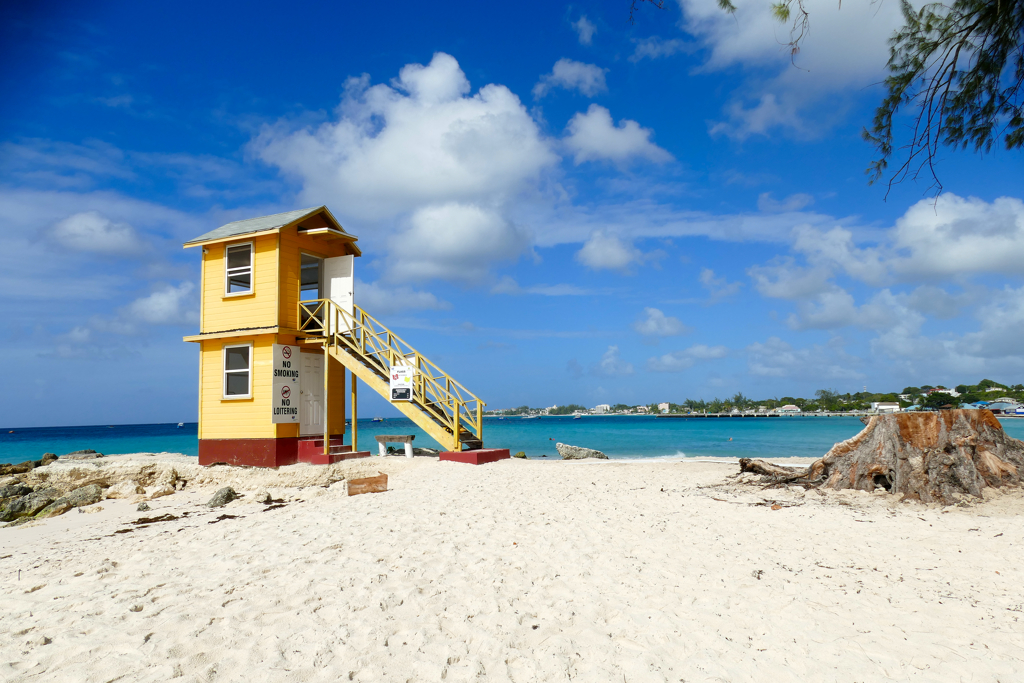
I, for one, absolutely agreed with Typically Tropical and made my way to Barbados. Since their song remained a one-hit-wonder, I’m pretty sure the duo has given up their career by now; and who knows, maybe they retired in Barbados.
Howsoever, in this post, I’m taking you to the best places the island has to offer.
Welcome to Barbados!
Like major parts of the Americas, Barbados has a rich and complex history shaped by waves of colonization, hardship, migration, emancipation, and progress. Long before European ships arrived on its shores, the island was home to the Arawaks, peaceful farmers and fishers. They were later displaced by the warlike Caribs, who dominated vast parts of the Caribbean. Until the age of exploration, the island remained untouched by European powers.
In the early 16th century, sailors from Portugal and Spain stumbled upon the island. Though they never settled, they created the name Los Barbados, referring to the fig trees whose hanging roots resembled beards. But it was the English who would change the course of Barbados’ destiny forever. In 1627, the first British settlers landed, claiming the island for the English Crown. They transformed it into an agricultural colony – quickly and mercilessly.
Sugar, Sugar
At first, small-scale farms dotted the land, growing tobacco and cotton. However, by the 1640s, sugar cane became the island’s white gold, bringing immense wealth to the British plantation owners. To sustain the demanding industry, thousands of enslaved Africans were kidnapped to Barbados. By the late 17th century, they made up the majority of the population. Life on the plantations was brutal, with enslaved people enduring unimaginable hardships under a harsh and oppressive system.

The profits from sugar sales made Barbados England’s richest colony. The island became known as Little England. Speightstown, the second trading town on the northwestern coast of the island, was nicknamed Little Bristol.
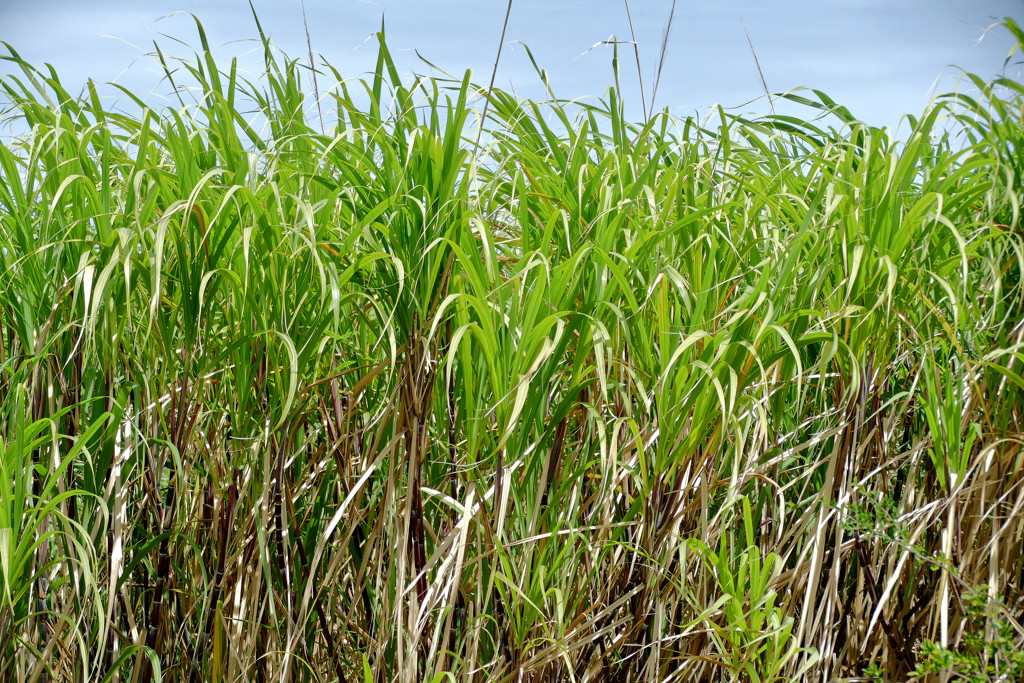
What sounded endearing and like praise at the time is now more of a disgrace to Britain’s past. You can find out more about this in my post about Bristol.
Intruders from Foreign Lands
For more than two centuries, a powerful plantocracy, hence, a small group of white land- and slaveowners, ruled in Barbados with an iron fist. They dominated politics, economics, and society. Yet, resistance simmered beneath the surface. Enslaved people fought back through revolts and rebellions. In 1834, slavery was finally abolished. Even so, freedom was only a charade at first as former slaves were forced into a cynically called apprenticeship system until 1838. As a result, they remained essentially tied to the plantations.
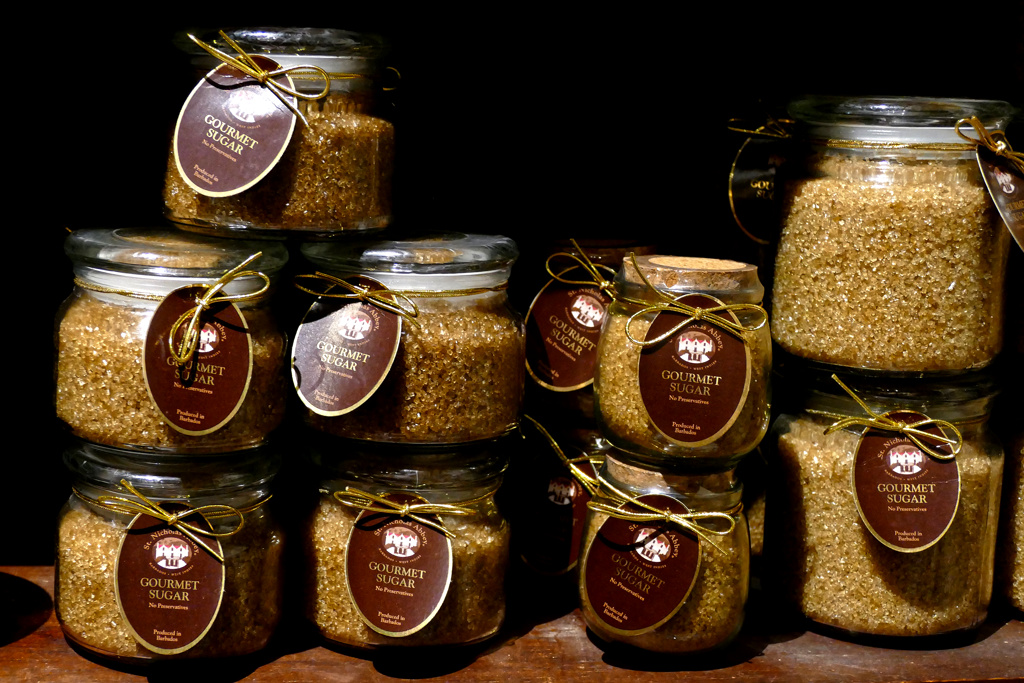
The 20th century brought new challenges and opportunities. Economic hardship led to the rise of working-class movements, with Barbadians demanding better wages and political representation. In 1938, the Barbados Labour Party was founded, ushering in a new era of political activism. By 1951, universal suffrage was granted, allowing all Barbadians to vote and shape their future.
Fun Fact
To this date, the British government has neither paid reparations nor apologized to the people it enslaved, or their descendants.
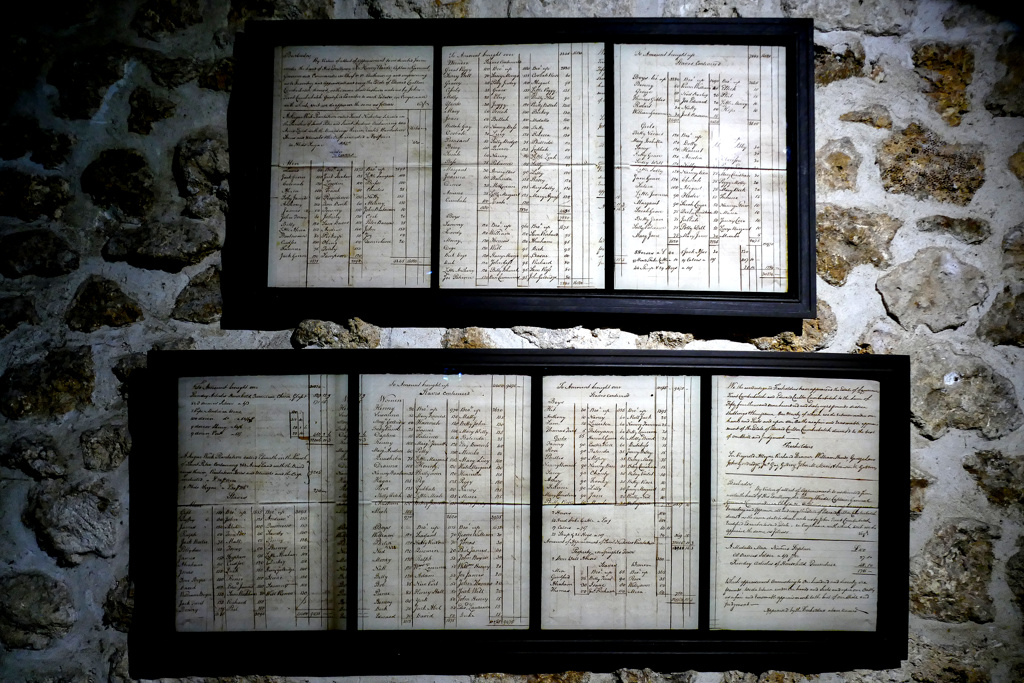
However, Great Britain was not fundamentally stingy: the British government paid 20 million pounds in compensation to more than 40,000 slave owners for the loss of their human property after the abolition of slavery. That would be around 300 million pounds in today’s currency.
That’s a lot of money.
Therefore, the British government had to take out a loan in 1833 to be able to pay said compensation, which British taxpayers paid off only by 2015. So the bitter truth is that those who paid taxes in Great Britain before 2015 were indirectly and retrospectively co-financing slavery. I’m afraid many weren’t even aware of that.
Free at Last
The dream of independence became a reality in 1966 when Barbados finally broke free from British colonial rule. Under the leadership of Errol Barrow, the island’s first Prime Minister, the nation embraced democracy, education, and economic growth. No longer reliant solely on sugar, Barbados expanded into tourism, financial services, and manufacturing. In fact, it has become one of the most prosperous nations in the Caribbean.
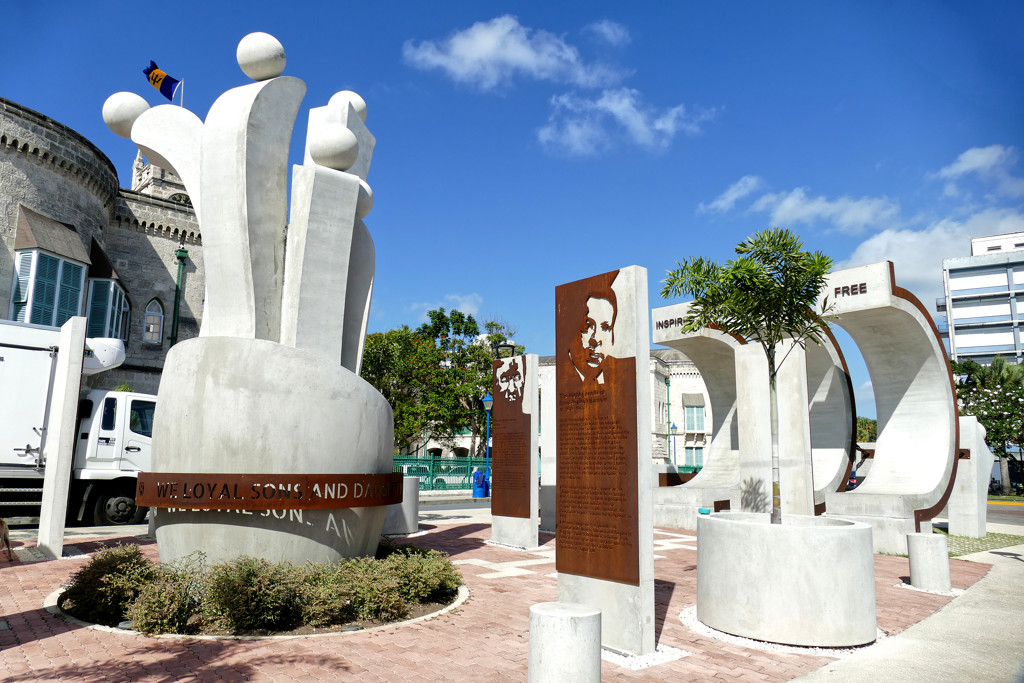
Yet, Barbados’ evolution did not stop there. In recent years, the island has taken bold steps towards self-definition. On November 30, 2021, exactly 55 years after gaining independence, Barbados officially became a republic, removing the British monarchy as head of state. Dame Sandra Mason was sworn in as the island’s first President, marking a new chapter in its history.
Today, Barbados stands as a beacon of stability, democracy, and progress in the West Indies. With a strong focus on education, healthcare, and renewable energy, the island continues to shape its destiny while preserving its cultural heritage and embracing also its dark legacy.
February is the Bridge to Brighter Days
Well, I sure do hope this saying is correct since, for me, the month of February is rock bottom when it comes to the meteorological calendar. Indeed, none of the winter months is my favorite, however, the others have celebrations, lights, and miracles in store that make up for the depressingly dull weather. As these festivities are over, February leaves us basically empty-handed. At least it’s a bit shorter than its more hospitable siblings.
Because February is such a downer, I – a little belatedly – join the migratory birds and escape the cold and depressing gray into warm, colorful, and merry realms.
I explore the Caribbean islands.
This year, I also had problems with an old injury. Three years ago, I suffered an open fracture in my left ankle in a ravine on Gran Canaria, and after everything was peachy at first, the injury has been causing me problems walking for several months. And since Barbados has a reputation for having much less to do and discover than most other Caribbean islands, I chose this island. I had to find a way to overcome my severe case of FOMO.
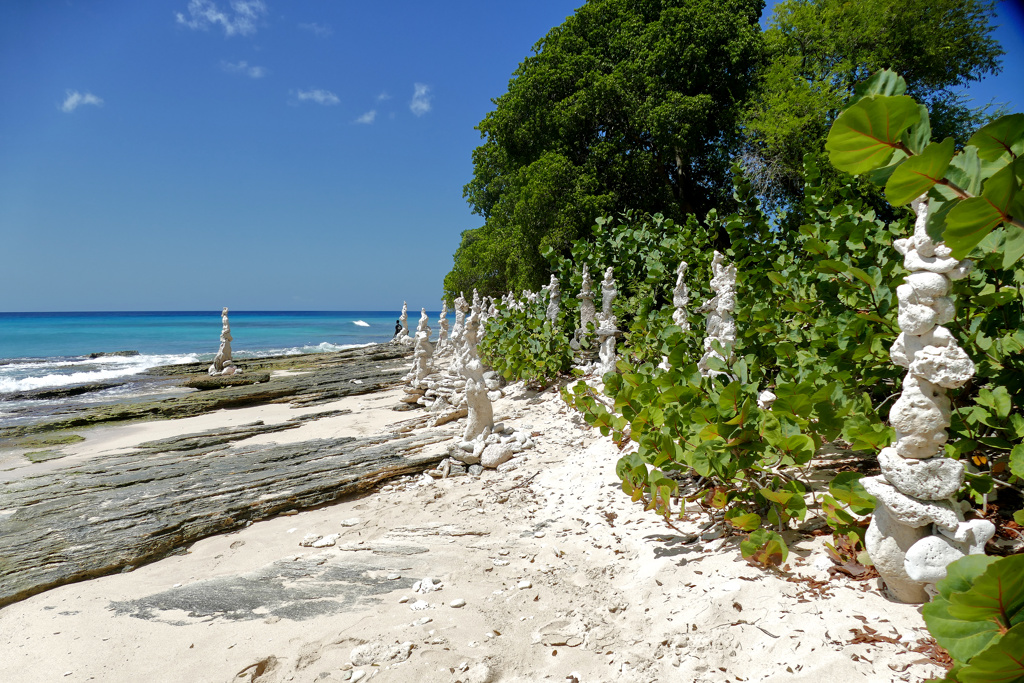
Well, I didn’t completely succeed because Barbados is more interesting and varied than its reputation. Still, the attractions outside of the breathtakingly beautiful beaches aren’t so overwhelming that you feel the urge to constantly rush from one landmark to another. No, Barbados offers the perfect mix of history, culture, sport, and entertainment – and lots and lots of peace and relaxation.
The Best Places Not to Miss in Barbados
My guide starts in the spot where most Bajans live, namely, the island’s capital, Bridgetown. From there, I’ll guide you alongside the calm waters of the West Coast all the way up to the second-largest city of Speightstown. That’s actually a great gateway to the attractions on the northern half of the island, such as the Animal Flower Cave and Saint Nicholas Abbey, from where we’ll be going down the rough eastern coast. As this side faces the Atlantic, it’s great for surfing but not suitable for swimming. However, since this part of Barbados is particularly picturesque, it’s absolutely worth a visit.
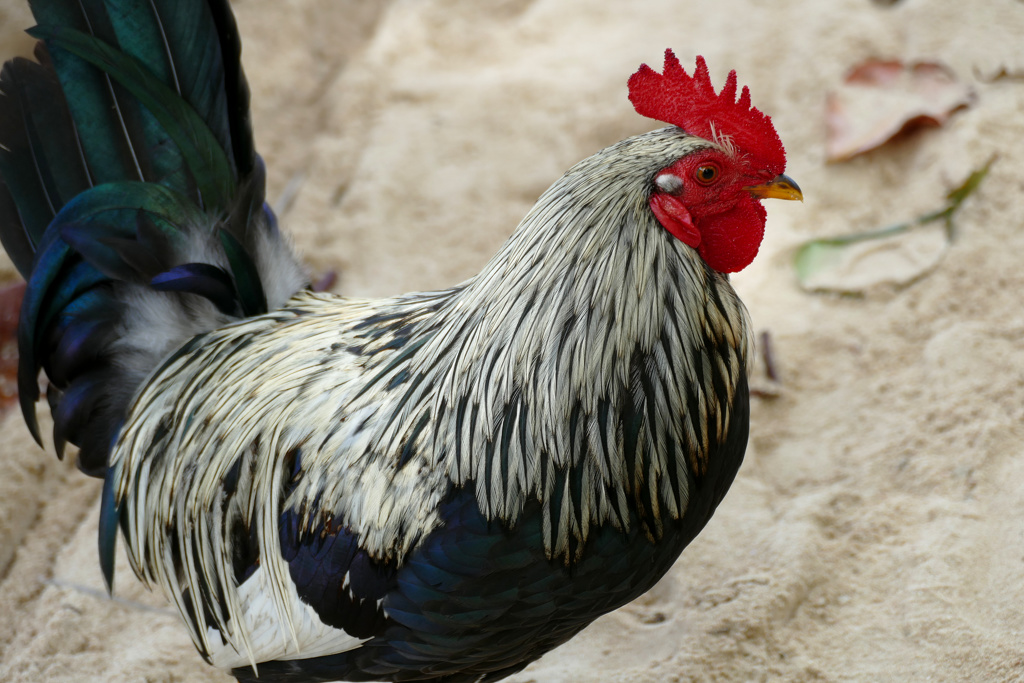
Finally, we’ll reach the south coast with all those hotels and resorts. Yet, you’ll be amazed how quickly you can get away from the tourist madness and immerse yourself in true Bajan life. Take it from me: Although I stayed in Oistins, likely Barbados’ most notorious tourist area, I enjoyed three weeks of serenity – only interrupted by the occasional crow of a rooster.
Bridgetown
Historic Bridgetown and its Garrison are an example of British colonial architecture, consisting of a well-preserved old town dating from the 17th, 18th, and 19th centuries. This also comprises a huge military garrison, including several historic buildings. UNESCO added the old town and the garrison to the World Heritage List in 2011.

Aside from this impressive historical part, Barbados’ capital is also located on Carlisle Bay, which is lined with some of the most beautiful beaches on the island.
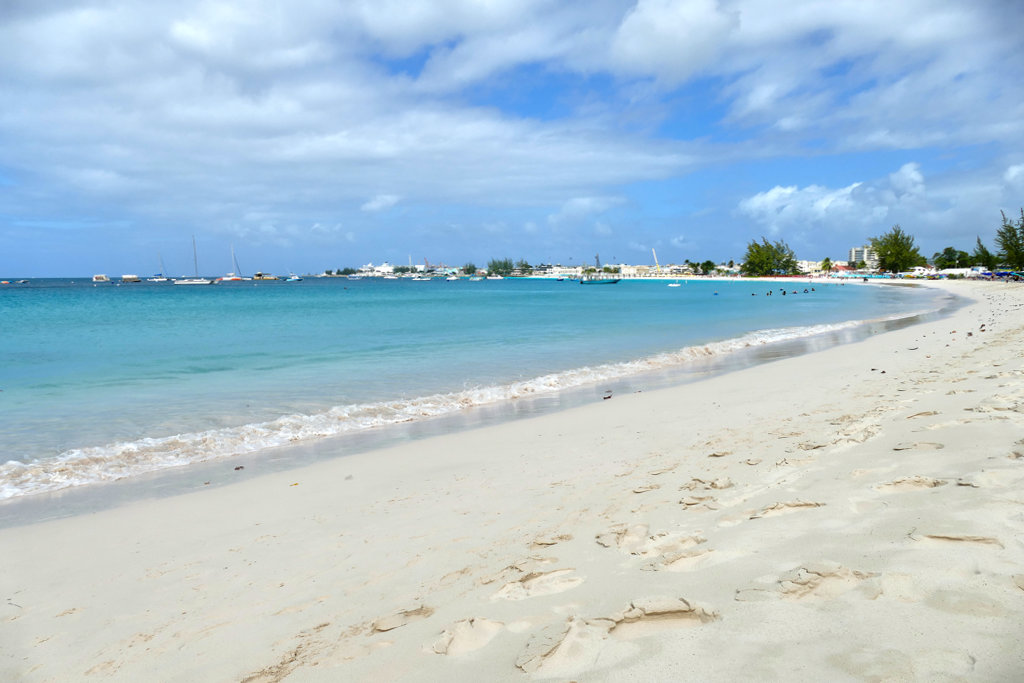
Because Bridgetown has so much to offer, it would go beyond the scope of a general post about Barbados to list all the sights you absolutely should see.
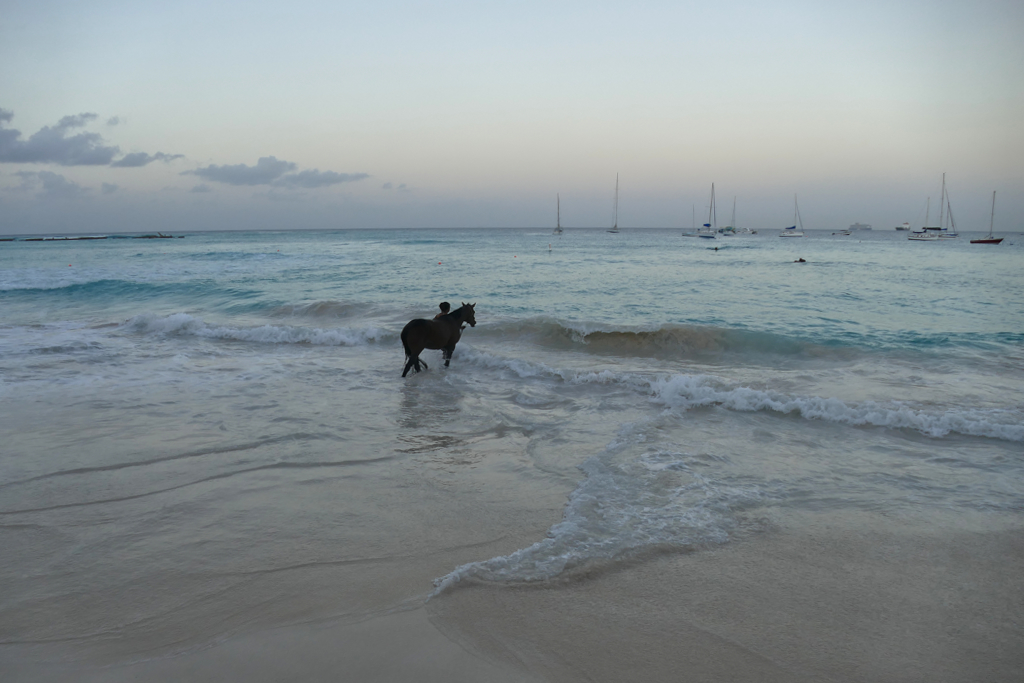
I am therefore presenting Bridgetown separately in my detailed guide What Not to Miss in BRIDGETOWN, Barbados’ Exciting Capital.
And to make the most of your beach holiday, I recommend my post Beyond Your Imagination: The Best Beaches in Barbados You Can Easily Visit by Public Bus
Along the West Coast
The west coast of Barbados, often referred to as the Platinum Coast for good reason, is known for its stunning white sand beaches, calm turquoise waters, luxury resorts with golf courses, and fine dining. This coastline stretches from Bridgetown and ends in Speightstown in the north, making it a popular location for travelers seeking upscale accommodations and experiences.
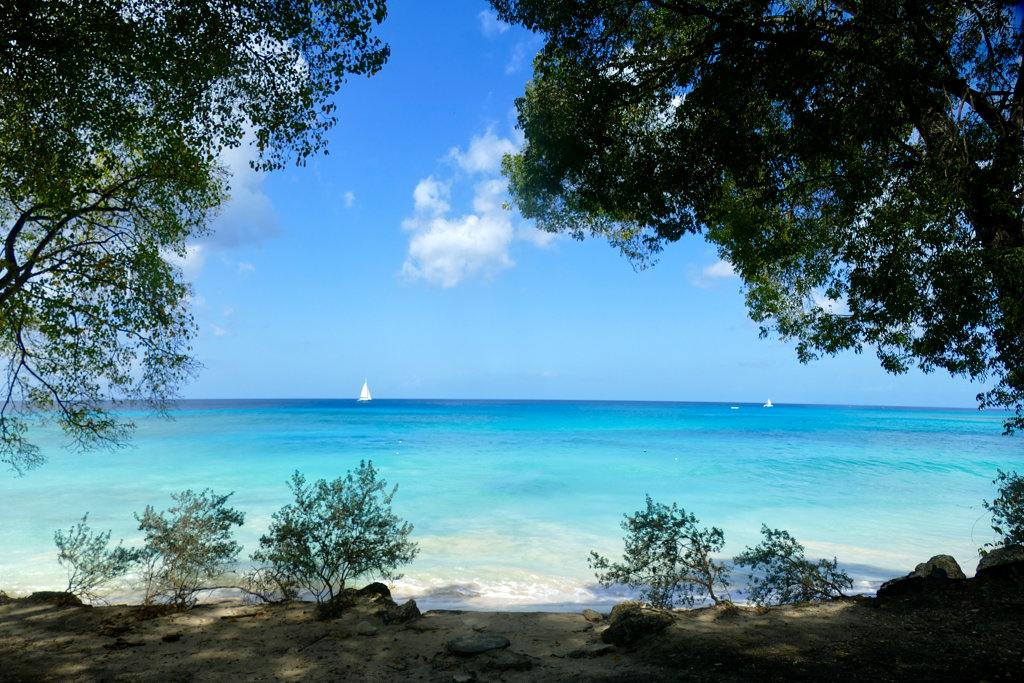
Since the west coast is home to some of the island’s most beautiful beaches, it is indisputably a must when visiting Barbados. In addition, the two towns of Holetown and Speightstown are absolutely worth a visit. Holetown was the first British settlement in Barbados in 1627. Later, however, it lost importance as Bridgetown emerged as a larger commercial and administrative center and became the capital. Today, Holetown is a lively tourist center with great shopping, restaurants, and nightlife. In contrast, Speightstown has retained its somewhat serene, secluded atmosphere. Yet, in the 17th century, Speightstown was the most important port for the export of sugar and other goods to England.
Beaches
As I wrote above, you actually don’t have to leave Bridgetown to enjoy some of Barbados’ best beaches. Still, you should do so, either to avoid missing a beach that might have even more to offer or to verify that you’ve already found your favorite beach. And thanks to Barbados’ excellent bus system, beach hopping along the west coast is easy, quick, and inexpensive. The buses travel from Bridgetown along the Black Rock Main Road, and once they reach the Frank Worrel Roundabout, they continue more or less right next to the coast all the way to Speightstown.
Welcome to Paradise
The southernmost of the beaches I’d like to feature in this post is Paradise Beach. As it is not directly accessible from the road, despite its beauty, it remains a rather hidden gem that is also popular with locals.
In front of the ruins of the now-closed Paradise Beach Hotel, you will find golden sand and turquoise water with excellent swimming conditions. As the water is usually gentle and clear, it is also ideal for snorkeling.
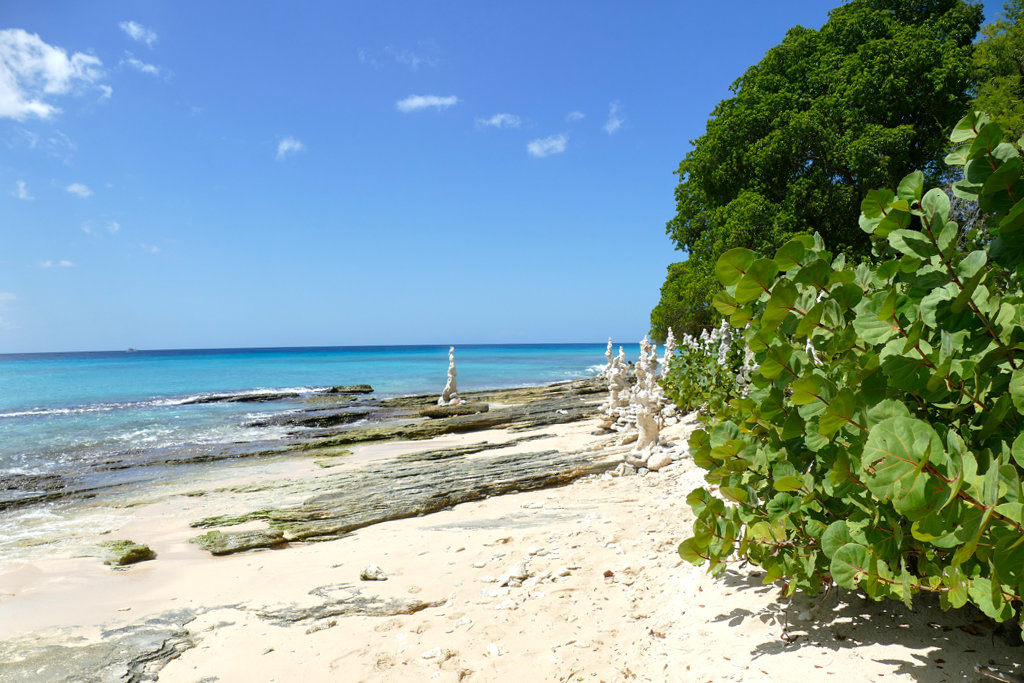
To the surprise of many, Paradise Beach is a place where art and nature collide in the most mind-bending way! Scattered along the northern tip of this idyllic shoreline, you’ll find a mesmerizing collection of the so-called Seafloor Sculptures.
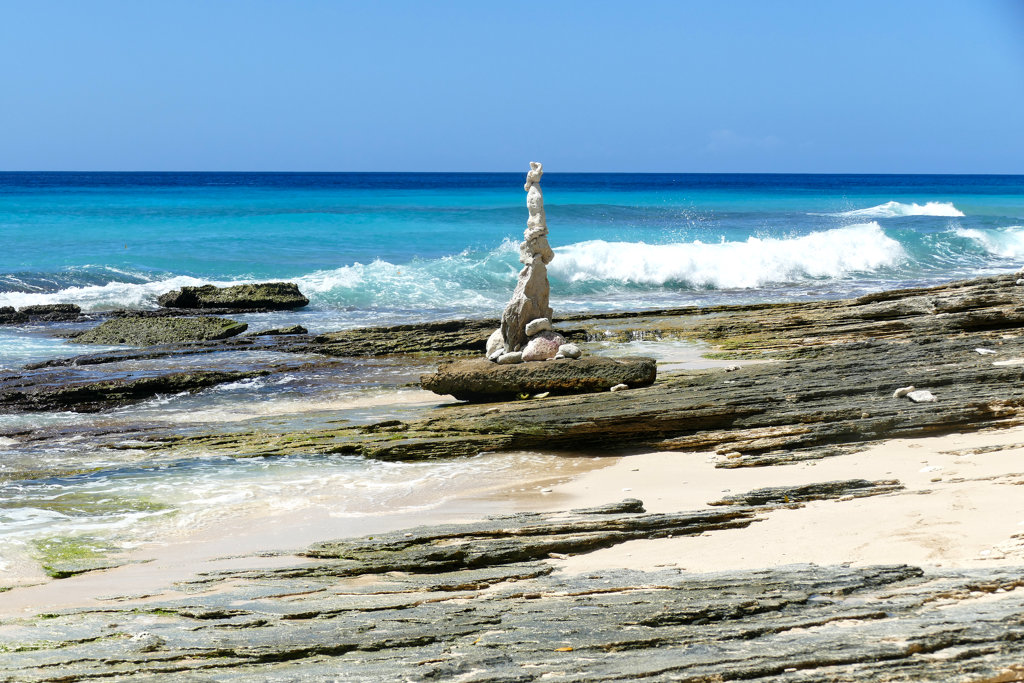
They were created by local artist Philip King. What started as simple stone stacks has now blossomed into a jaw-dropping display of towering rock formations. Some soar up to six feet tall. Each sculpture is a masterpiece of patience and precision, with King carefully selecting and balancing each rock to create structures that look as if they shouldn’t even be standing.
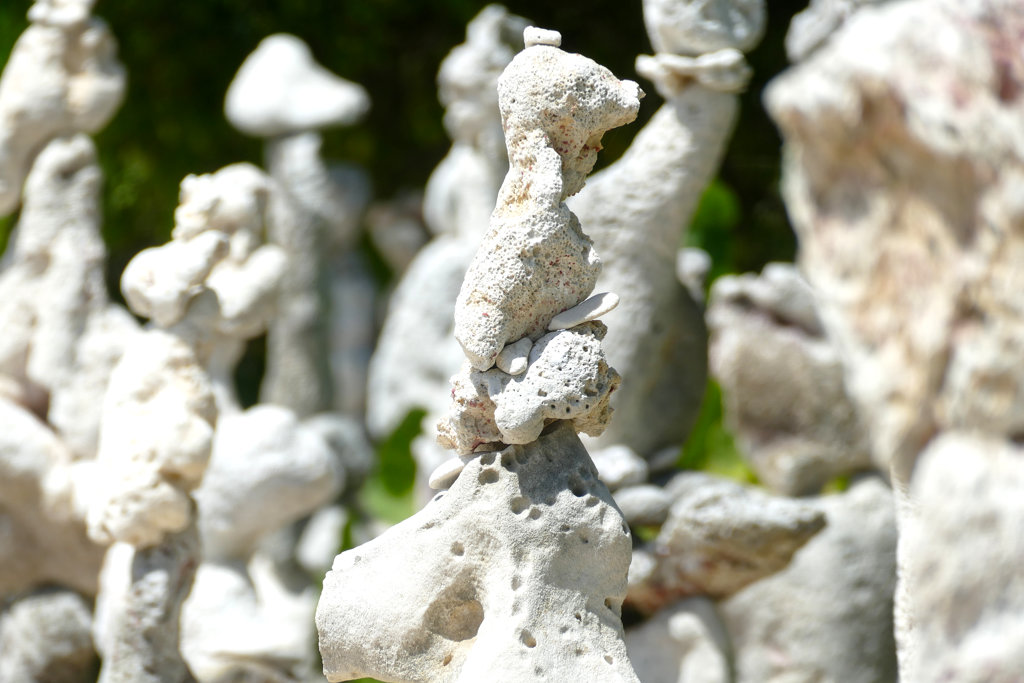
At any given moment, around thirty of these precarious beauties dot the shoreline, subtly shifting as the ocean breeze, the tide, or an awestruck passerby nudges a stone out of place. But don’t worry, the artist returns to rebuild them patiently, ensuring that the magic never fades.
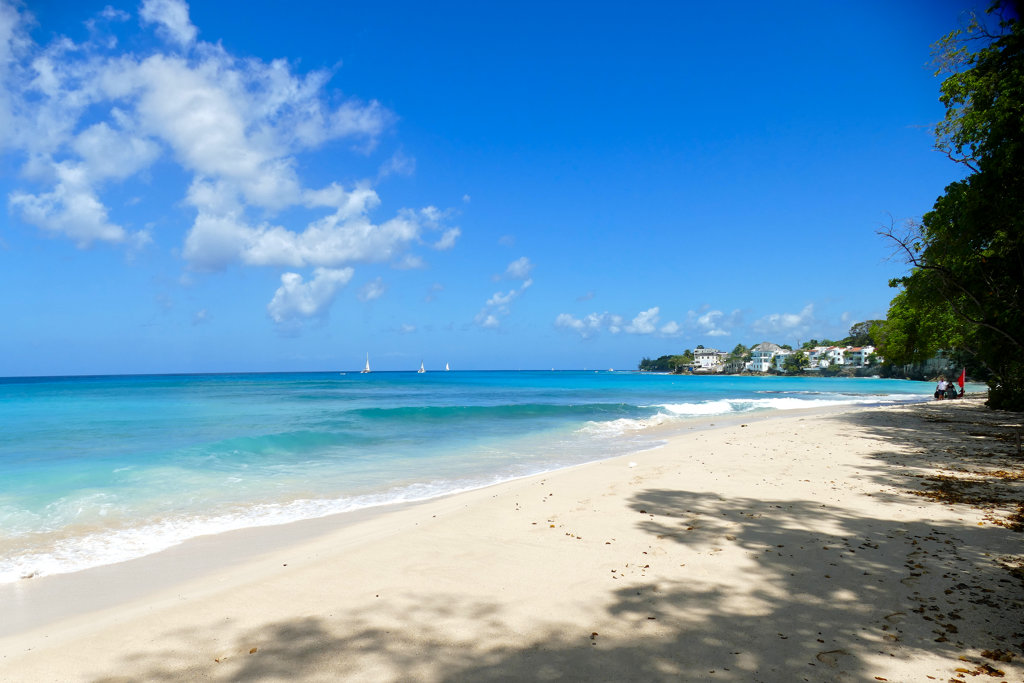
Paradise Beach itself has no facilities. But it is only a ten-minute walk from Batts Rock Beach, where you will find amenities such as fresh water showers, toilets, and the trendy beach bar La Cabane.
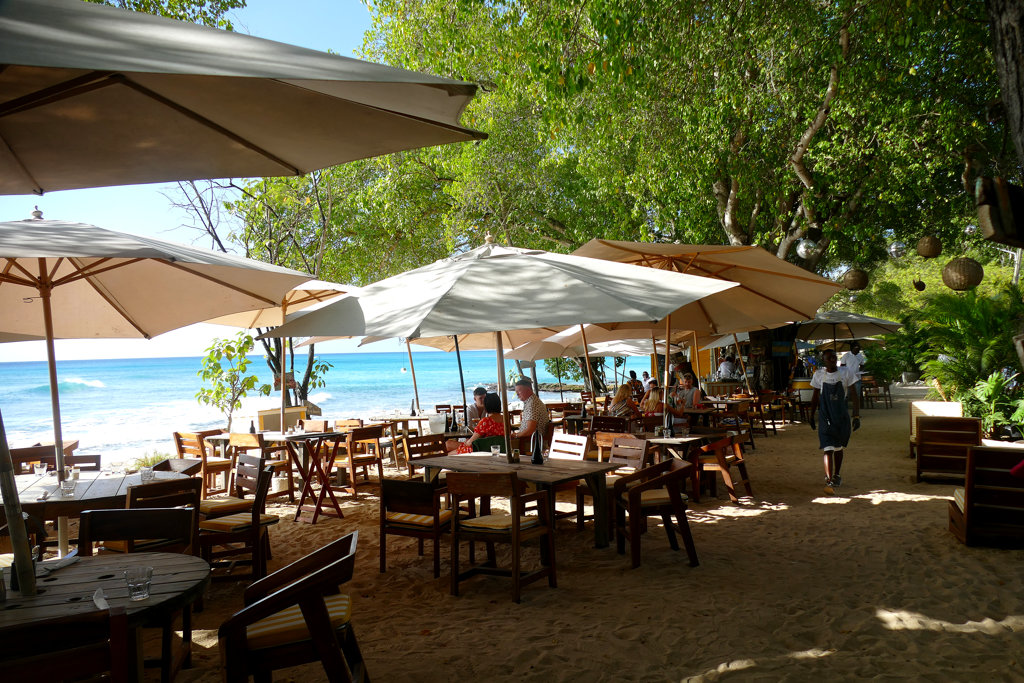
Batts Rock Beach is gorgeous and has a more sophisticated feel due to its proximity to the bar and some upscale hotels. There is also much more and taller vegetation here than on Paradise Beach, so there is enough shade for everyone. However, you have to compromise on seclusion.
Underwater Love
Barbados has 80 beaches, and I obviously cannot introduce them all. Therefore, I’ll skip a few bays north of Batts Rock Bay and take you straight to Folkestone Marine Park on the outskirts of Holetown.
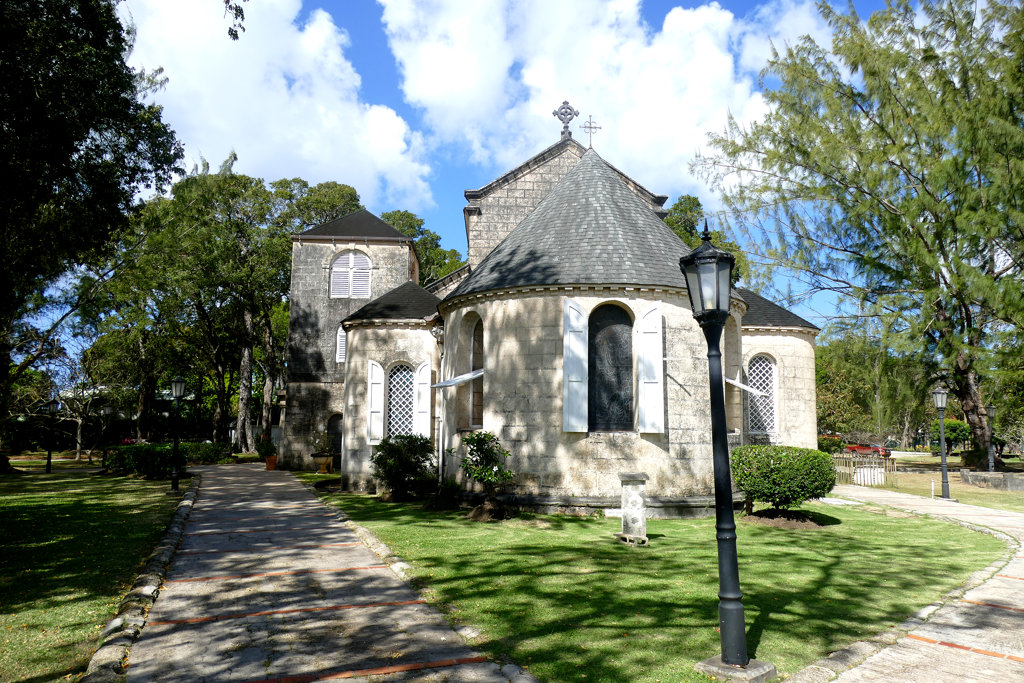
This protected marine reserve is a must-see for nature lovers, snorkelers, and divers as it offers an incredible insight into the island’s vibrant underwater world, making it a paradise for anyone who wants to do more than just laze on the beach.
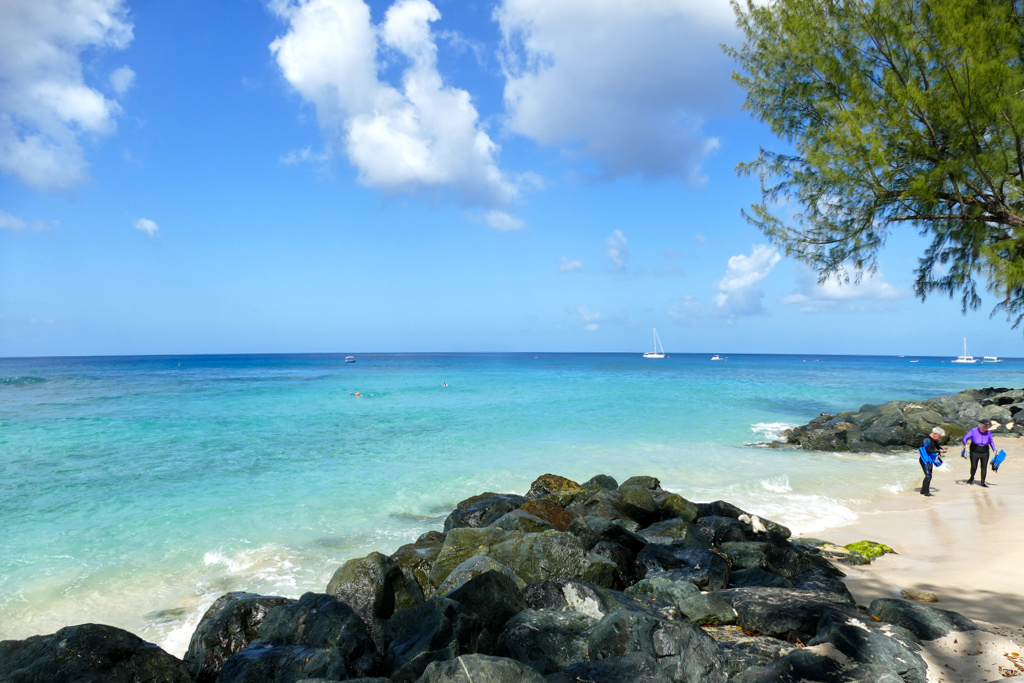
The highlight of the park is the coastal reef, which is full of colorful fish, gorgonians, and corals. It’s perfect for snorkeling as you can see parrotfish, sea turtles, and even the occasional stingray up close in the shallow waters. For those looking for a bigger adventure, the Stavronikita, a 365-foot Greek freighter, lies about a mile offshore at a depth of 120 feet. This is an exciting dive site even for experienced recreational divers.
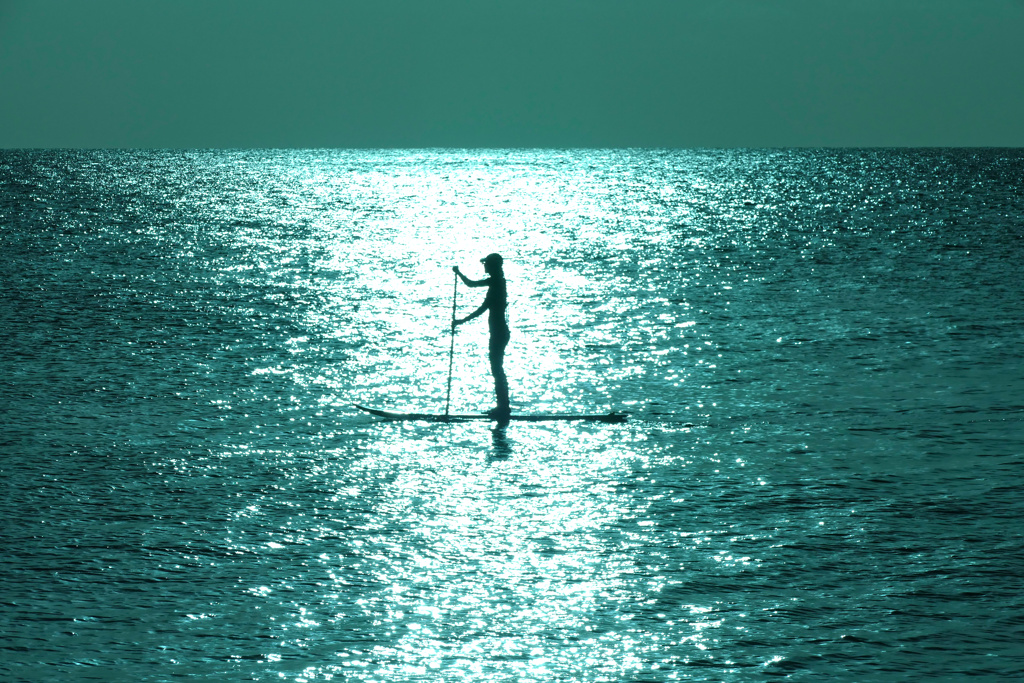
To end the day, I recommend going to Reeds Bay, about 3.5 kilometers further north. Here, you can enjoy a last dip in the water before watching the sun go down with your feet in the sand and a drink in hand while listening to live music at the popular Thunder Bay beach bar.
Speightstown
So, after hopping from scenic beach to scenic beach, you finally reach Speightstown, the second-largest town in Barbados.
The British founded Speightstown in 1630. The town’s name comes from William Speight, a settler and former owner of what is now the town area. Yes, it was not uncommon for a single colonial ruler to own so much land that an entire town could be built on it. As a matter of fact, Barbados still has a number of plantations and properties that were paramount in the colonial era. After emancipation, over half of the nearly 1000 plantation estates became tenantry villages. To this day, they remain villages. Yet, many of the properties are not privately owned anymore but are managed by the Barbados National Trust.
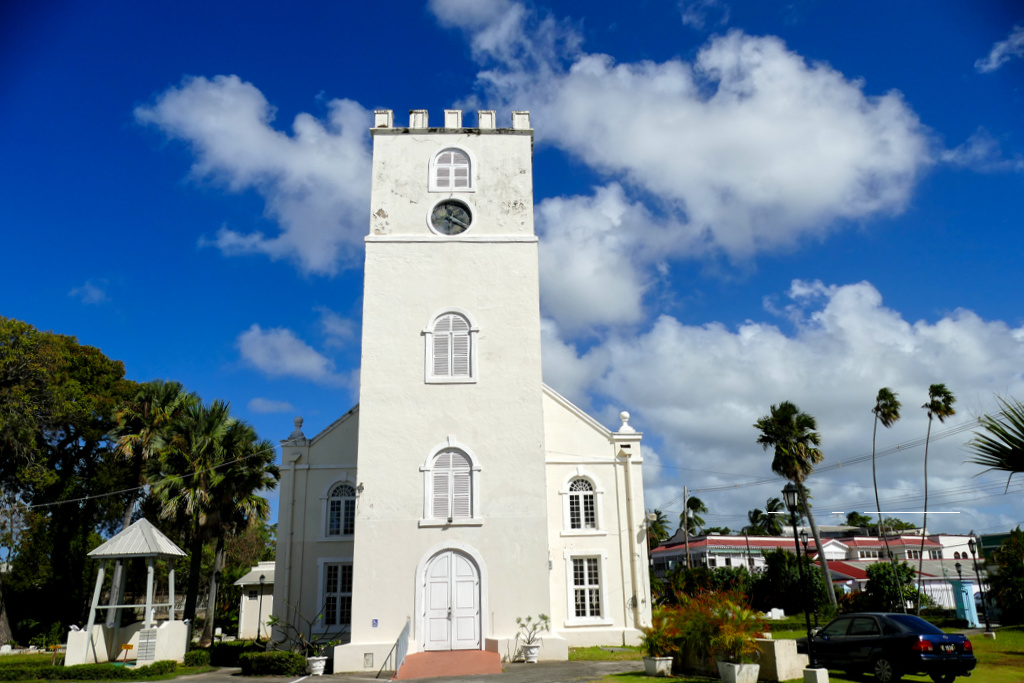
In the 17th century, the port of Speightstown played an important role in the infamous triangular trade, in which European products were exchanged for African slaves who were transferred to the colonies. The raw materials produced by these poor people were then shipped to Europe. As part of this triangular trade, merchant ships loaded with sugar and other goods regularly sailed from Speightstown to London and Bristol. At that time, Speightstown was also nicknamed Little Bristol.
Overvalued or Underrated?
Travelers often claim that Speightstown is a hidden, underrated gem and has so much to offer. If it’s not about the surrounding area, but actually about the town itself, I would dispute that. Speightstown is neither especially interesting nor particularly picturesque. And I think it’s a bit tone-deaf to rave about alleged colonial charm, given the cruelty the abducted and enslaved people had to endure on the plantations and in the mansions.
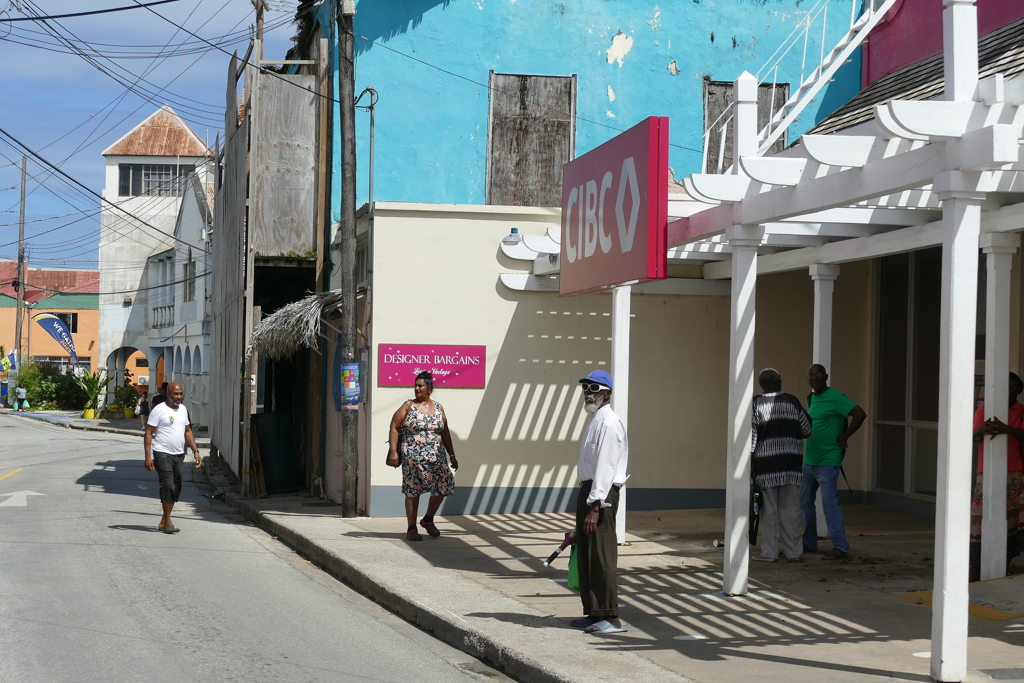
However, if you consider the area around Speightstown and the fact that it is an excellent base for driving to more remote places in the north and northeast, then I agree. Head to Speightstown! And yes, you can take the opportunity to stroll around the town a bit, even if you probably won’t write home about it.
Take a Look Around
The main street, Queen Street, runs parallel to the shore. Here you will find shops, the fishing complex, and some restaurants. Make sure to pay the Fisherman’s Pub right next to the pier a visit for some authentic local food and an unforgettable sunset.
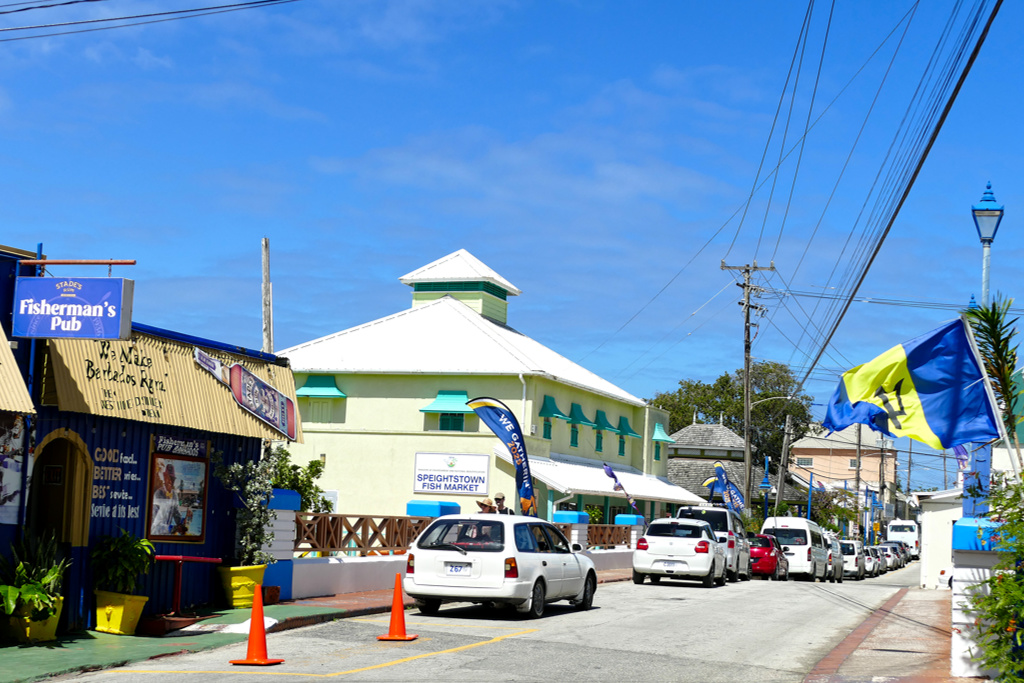
You can also still see some of the large houses of the wealthy merchants of a bygone time. For example, the Arlington House, which the wealthy merchant family Skinner owned for generations. Its rather plain architecture was a model for other merchant homes in Speightstown in the 18th Century. Nevertheless, a fire near the bridge on Queen Street destroyed many of these old buildings in 1941.
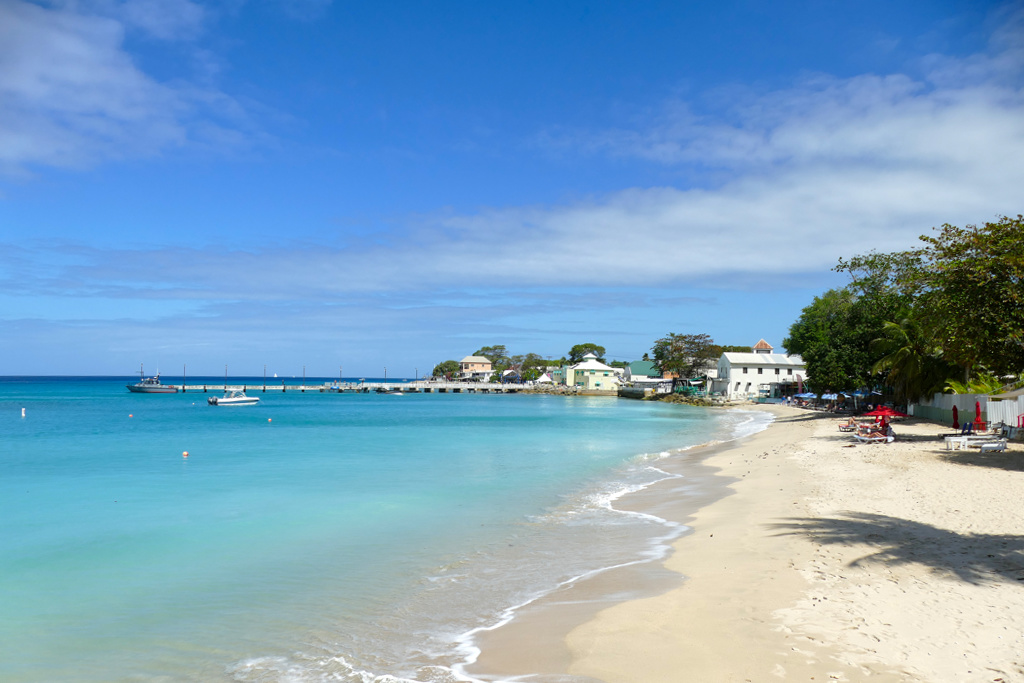
To this date, remains of the fortifications are found in the city center. Dover Fort is now partly used by the police. The former Denmark Fort is an esplanade on which some of the cannons that once secured the harbor stand. The neighboring Orange Fort now serves as the fish market.
Fun Fact
When the roads were not yet so well developed, the fastest way to get from Speightstown to Bridgetown was on a sailing ship, which took only 45 minutes!
Even though I think that easy access is Speightstown’s greatest asset, don’t jump on the next bus just yet. You should at least enjoy a little of the city beach north of the center.
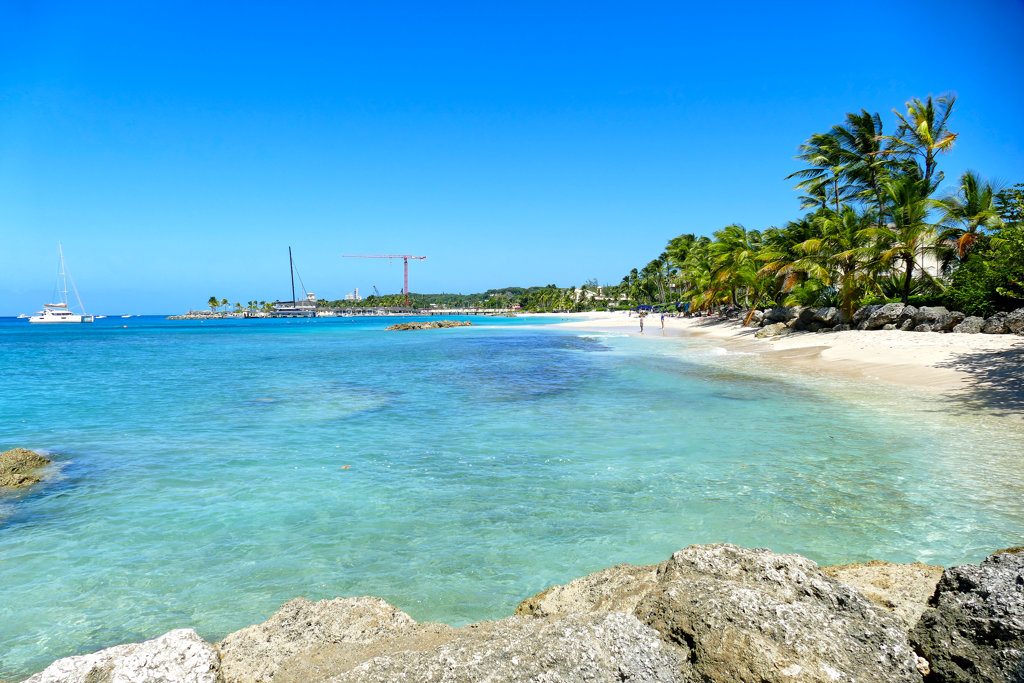
It’s even better if you walk about 20 minutes towards the luxury marina Port St. Charles Marina*, where you’ll reach the stunningly beautiful Heywoods Beach.
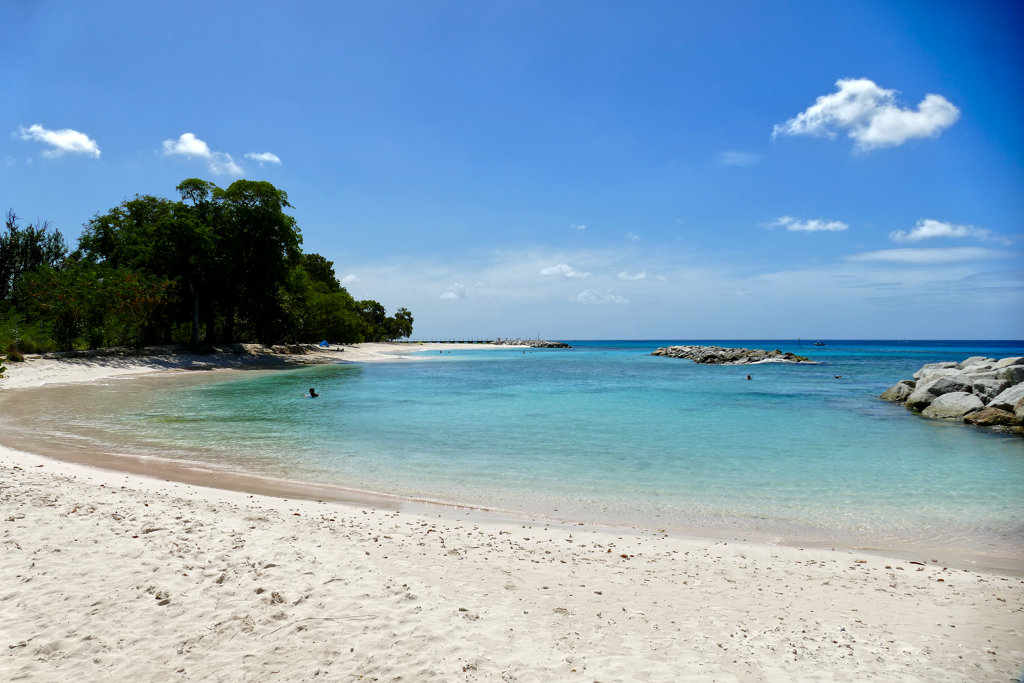
This fine sandy beach stretches out along the crystal clear water in a series of smaller bays. You have to see it to understand why Heywoods Beach is by far my favorite beach in all of Barbados.
The Lush Hinterland
Yes, Speightstown is not only a historically interesting place, but also surrounded by some of the most beautiful beaches that Barbados has to offer. Most importantly, Speightstown is an ideal starting point for exploring the fertile hinterland and the wild north of the island. All types of buses leave the bus terminal in all directions almost every minute.
Saint Nicholas Abbey
Despite the relatively high entrance fee, the Saint Nicholas Abbey estate is one of the most popular attractions on the island and can be reached from Speightstown in around 20 minutes. Take the minibus towards Boscobelle and tell the driver where you want to go. He will then let you out on the main road, from where you can walk along a dirt track to the back entrance of the estate in around ten minutes.

Today, Saint Nicholas Abbey is one of Barbados’ most famous historic landmarks. Despite its name, it is not a religious site but a well-preserved plantation house and rum distillery dating back to the 17th century. The exact reason for its name is unclear. However, when the plantation was established in 1658, English settlers often named estates after saints or famous religious sites. Also, the term Abbey was sometimes used for grand estates or mansions to evoke prestige and importance, even if they had no religious ties whatsoever.

Saint Nicholas, though, could have been chosen as a reference to the patron saint of sailors and merchants, which would be fitting for a Caribbean island with strong maritime trade links.

Completed in 1658, Saint Nicholas Abbey is one of only three Jacobean-style mansions left in the Western Hemisphere. The house features Dutch gables, coral stone walls, and period furnishings.

Sugar was harvested on the plantation for centuries, and Saint Nicholas Abbey still produces small-batch, handcrafted spirits using traditional methods.
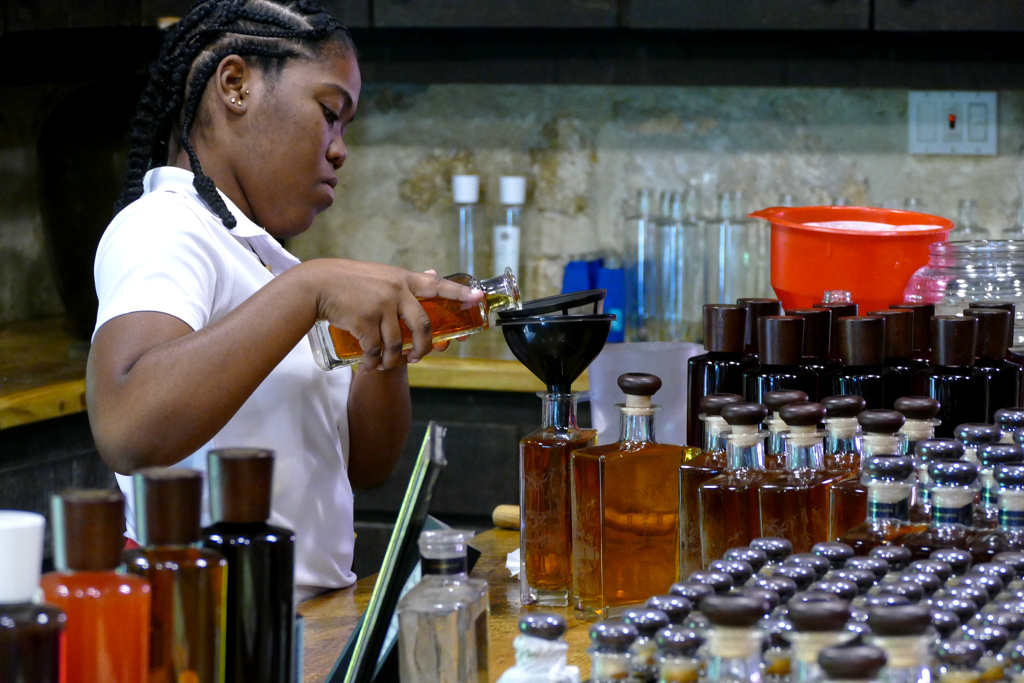
The main business, however, is offering visitors a glimpse into the lavish lifestyle of the colonial landowners as they can tour the great house, explore the tropical gardens, and watch historical film footage.
Right on Track
The highlight, however, is the ride on a historic-style steam train. It offers a unique way to explore the plantation’s lush landscape and experience a bit of the island’s history.
The railway was opened in 2018 and features a steam-powered locomotive modeled after traditional 19th-century trains.

On 2.5 kilometers, the train crosses through the historic plantation, mahogany forests, and scenic countryside to the top of Cherry Hill, from where you have a panoramic view of the rugged east coast. Currently, they are extending the tracks and planning further development, which you can see on an additional train ride.
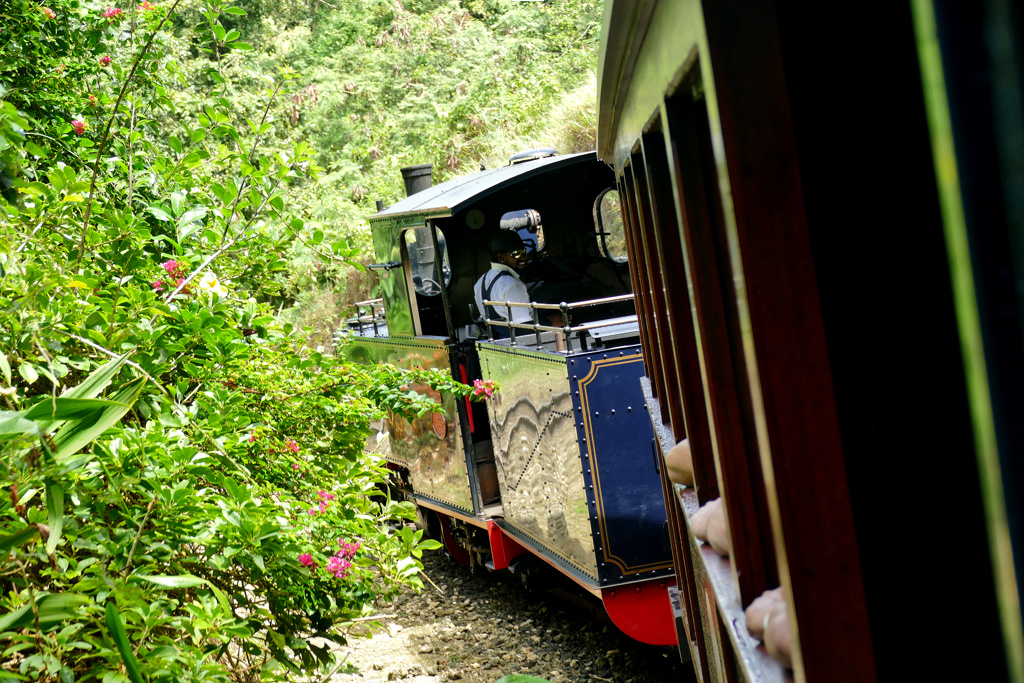
Saint Nicholas Abbey is open to visitors every day between 10 a.m. and 5 p.m. However, be aware that they are closed on Saturdays from April to November!
They offer different tours and packages, which start at 70 BBD with a simple tour of the Great House. Combined with a train ride to Cherry Tree Hill, you’ll have to pay 124 BBD. You can check all the different options on their website where you can also book your tickets.
Gullies
The colonial rulers were greedy. Not only did they enslave people kidnapped from Africa to work in their fields, they also destroyed cleared most of Barbados’ forests and the island’s rich flora for agricultural purposes.
Parts of this natural treasure were able to survive in the so-called gullies. Gullies are natural geological formations: As Barbados is primarily composed of coral limestone, over thousands of years, rainwater has eroded softer rock layers, creating deep channels.
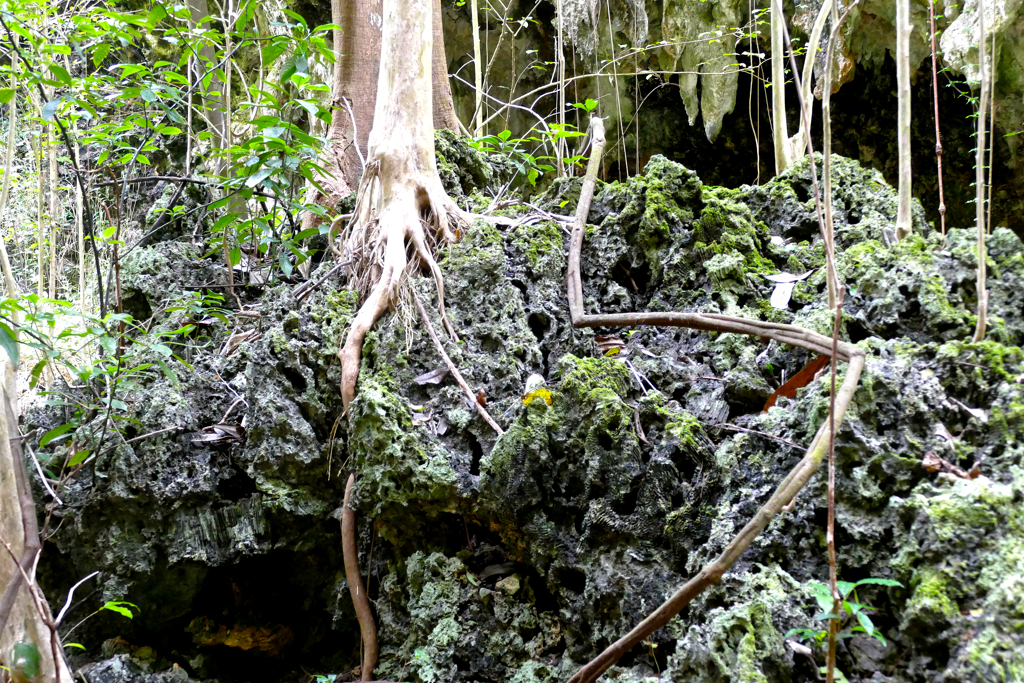
Gullies play a crucial role in the island’s ecosystem. These deep, narrow valleys cut through the limestone terrain, forming a unique network of natural drainage systems across the island. Gullies can be found all over Barbados and cover 5% of the total land area. They range from a few meters to several dozen meters in depth. Because they are difficult to access, many of the native plant species have survived there to this day. Gullies are often the last remaining refuges for endemic animal and plant species such as the native macaw palm and the bearded fig tree from which the island takes its name.
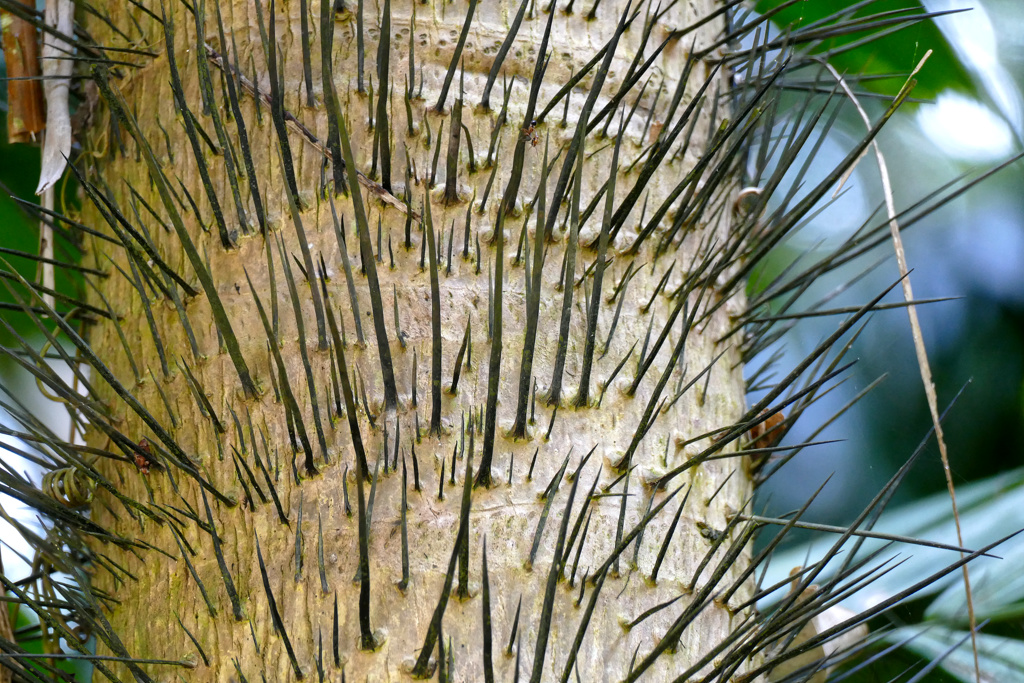
The lush vegetation in these gullies provides abundant food and habitat for wildlife species such as green monkeys. Reptiles such as lizards and the critically endangered Barbados thread snake, the smallest snake in the world, also make their home in these trenches.
Welchman Hall Gully
In addition to the Animal Flower Cave, Harrison’s Cave is a particularly popular attraction in Barbados. And while I was sad not to be able to visit the Animal Flower Cave for personal safety reasons, I decided not to take the tram ride through Harrison’s Cave for financial reasons. Sorry, 60 USD for stalactites and stalagmites is really too much for me. However, Harrison’s Cave is in the central uplands of the island, about 210 meters above sea level. The three characteristics of this region are sinkholes, caverns, and gullies, and just two kilometers north of the cave is Welchman Hall Gully.
If you’re looking for a peaceful nature escape with a mix of history and nature, Welchman Hall Gully is a must-see. It was once part of a plantation owned by a Welshman, which is where it gets its name. It is a natural limestone gully formed from the collapsed roof of an ancient cave where today, lush tropical trees and bushes grow.
The gully is home to a variety of exotic plants, including nutmeg, bamboo, and native palms. A well-maintained path allows visitors to explore the gully’s cool, shaded environment while learning about its diverse ecosystem. Nevertheless, for the best experience, you should definitely join a tour guided by one of their passionate guides. This way, you learn a lot about the practical, culinary, and even therapeutic use of the plants. In addition, Walchman Gully is also a great spot for birdwatching.
No Monkey Business
A troop of around 30 wild vervet monkeys lives in the gorge. Usually, they are lured to a specially built feeding platform with fruit in the mornings.
And troops of visitors are lured by the prospect of observing them in their natural habitat.
I am no exception.
Unfortunately, it had drizzled slightly that morning, and for reasons unknown to me, the monkeys are not fed when it rains. Anyway, the gully is their home, so they can come and go as they please. They are wild animals, and the Welchman Hall people want them to stay that way, hence, visitors are asked not to feed them.
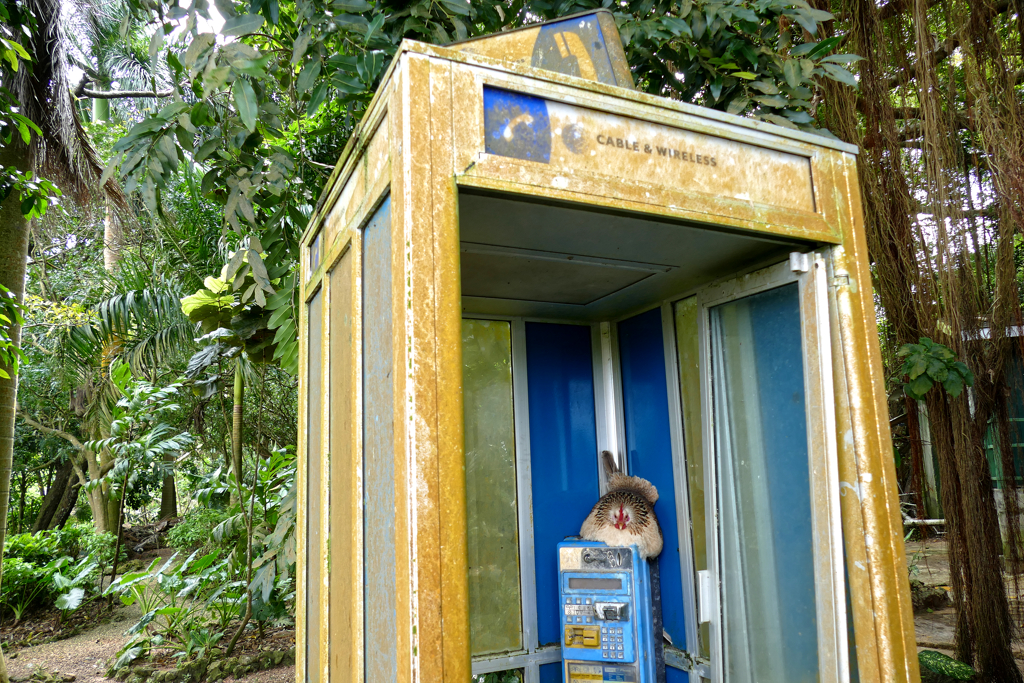
This being said, beware that thousands of monkeys live wild on the island. While they are an endearing attraction for tourists, local farmers consider them pests because they destroy their crops, especially fruit. The government has even put a bounty on their cute little heads.
While during the dry season from December to May, there is less rainfall, which makes the trails easier to navigate and increases the chance of seeing monkeys, on a visit during the rainy season, the gully appears even greener and more vibrant.
Welchman Hall Gully is open every day from 9 a.m. until 4 p.m. The general entrance fee is 30 BBD.
The reserve can be reached from Bridgetown in 30 to 40 minutes. Please note that buses leave from the Cheapside Markets, west of the center. The bus passes directly by the main entrance.
Hunte’s Garden
Hunte’s Garden is praised with great words: it is said to be the most enchanting place on earth. As a matter of fact, the park is located on the grounds of the former Castle Grant sugar plantation. And as we all know, sugar plantations were rather the most hellish places on earth for a great many people. But hey, let bygones be bygones.
Today, Anthony Hunte owns the grounds. Hunte himself grew up on the Balls Plantation on the south coast of Barbados, which his father managed.

About a decade ago, Anthony Hunte planted a garden in one of Barbados’ gullies by filling it with a variety of flowers and trees. A board shows over 80 species of flora and fauna, which you can then identify as you stroll through the garden. The small park is divided into perfectly curated sections, where a great number of well-tended flowers and bushes grow.
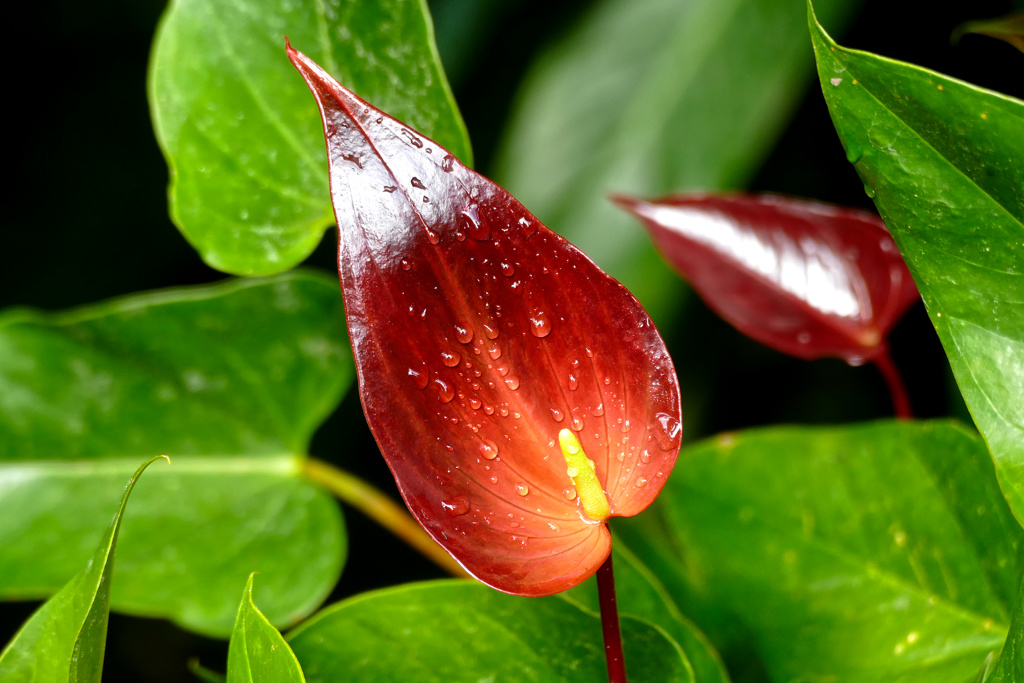
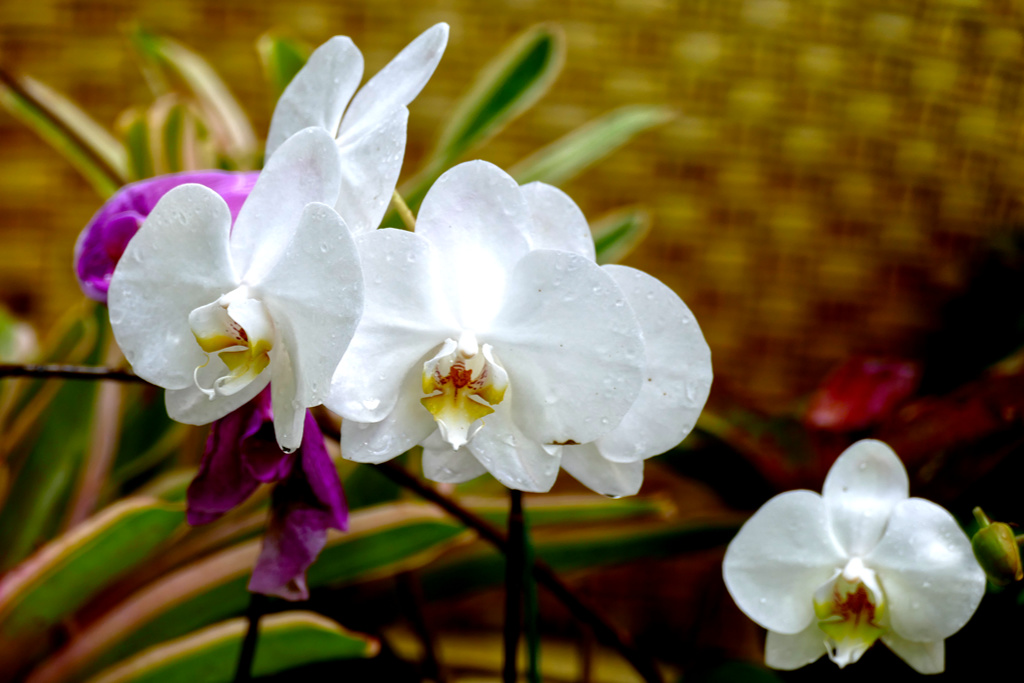

In between, you will discover enchanting ponds, fountains, and sculptures. You can also relax in one of the many seating areas and take it all in. When I read that classical music accompanies the walk through the garden, I thought it would be a bit tacky and annoying. In reality, however, the sound is quite discreet in the background and actually very charming.
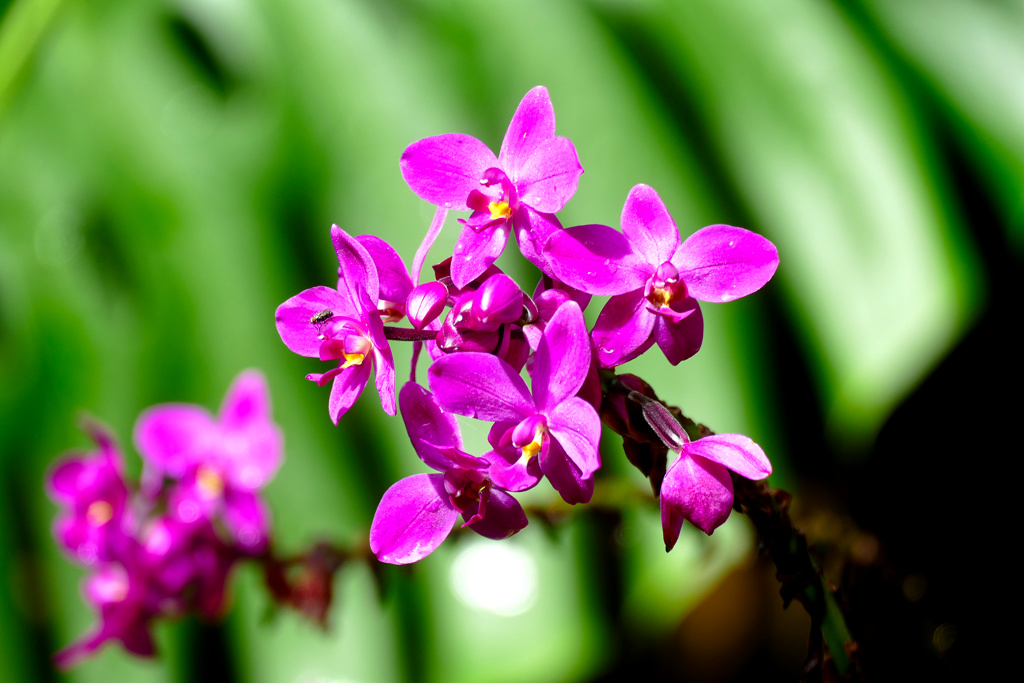
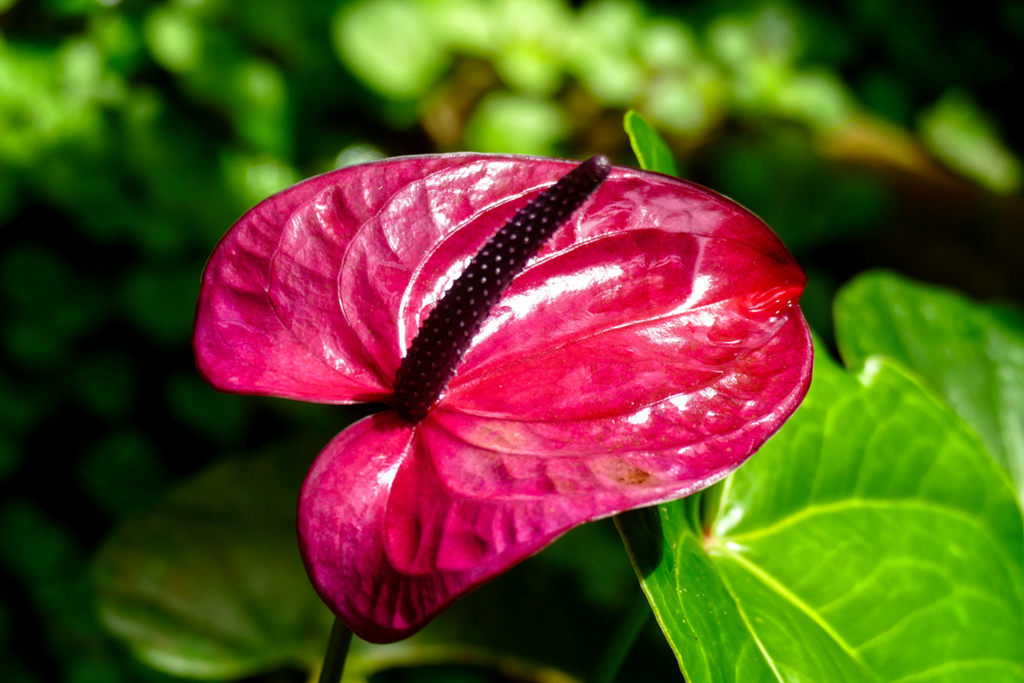
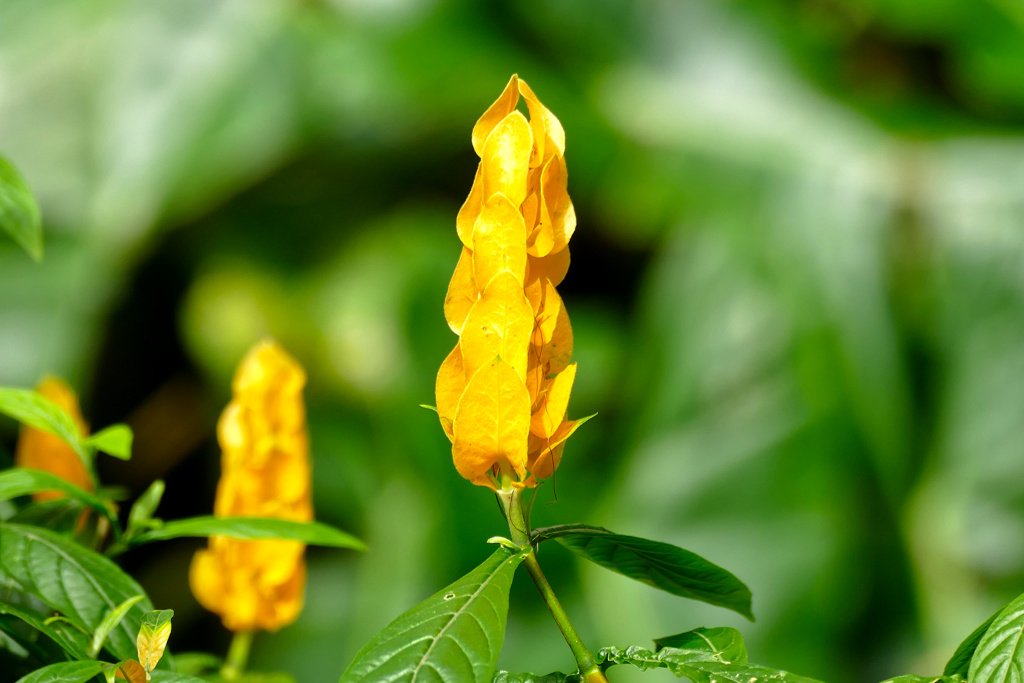
The gardens are surprisingly small. Even with a lot of dedication, you might need half an hour to walk around if you don’t stop to take a break in one of the nooks and crannies.

Finally, there are some picturesque, half-ruined buildings to look at and the manor house to visit. Here, you can sit on the spacious, colonial-style veranda and have some refreshments.
Doing the Math
Hunte’s Garden is open every day from 10 a.m. to 4 p.m., and the entrance fee is a whopping 40 BBD. That’s a lot of money. In my opinion, too much money to see flowers that mostly grow for free on the island. But I also have a general problem with the fact that the descendants of those who exploited the island for centuries are converting the colonial riches and heritage into landmarks and making a fortune from it to this date.
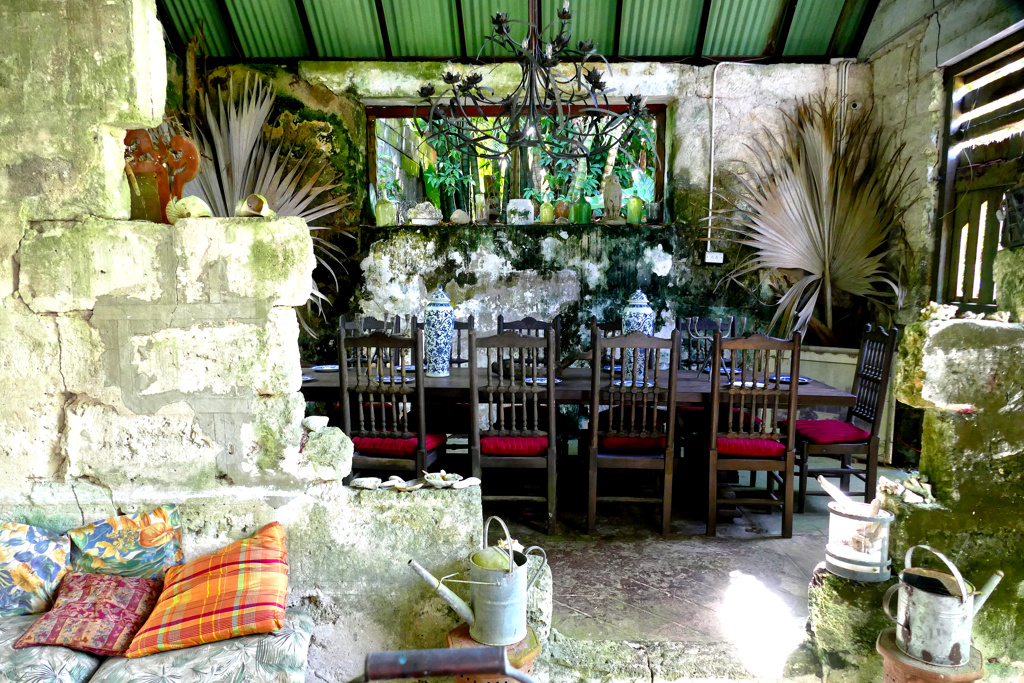
This being said, note that you can reach Hunte’s Garden from Bridgetown in 30 to 40 minutes. Keep in mind that ZRs leave from the Nursery Drive Minibus and ZR Terminal, east of the center. Tell the driver where you want to go. He then drops you off at a corner of Highway 3A, from where you have to walk around 15 minutes to the main entrance. Please note that the first part of the road is extremely steep downhill.
The big blue bus to Sugar Hill, which you can board at the main Fairchild Street Bus Terminal, stops right at the entrance. On the downside, it only goes there once an hour.
My Tip
You can comfortably combine a visit to Hunte’s Garden with a visit to Bathsheba Beach. Standing at the garden’s main entrance, turn left and walk southwards down Highway 3A. After about 15 minutes, you will reach a crossroad, Route 3. I have marked the exact spot on the map at the end of this post. From there, a minibus will take you to Bathsheba in less than 20 minutes.
There’s More
I don’t know if it’s because the sugar barons have decimated the flora on the island by growing sugar cane or what other reason there might be. But, as a matter of fact, I have never seen such a large number of botanical gardens and parks in such a small area anywhere else in my travels.
Apart from the two parks that I have presented in more detail above, there is also the so-called Flower Forest northeast of the Welchman Hall Gully near the village of Bloomsbury. Southeast of Harrison Cave is the Tropical Garden Barbados, which focuses mainly on orchids. On the eastern outskirts of Bridgetown lies the National Botanical Gardens. And last but not least, within walking distance from Bathsheba Beach is the Andromeda Botanic Gardens which female horticulturist Iris Bannochie founded around 70 years ago.
Along the East Coast
The latter Andromeda Botanic Gardens on the outskirts of Bathsheba is on the east coast of Barbados that opens onto the stormy Atlantic. It is known for its rugged beauty. Large rocks line the coast, and huge waves break on steep cliffs. Popular surf spots such as Bathsheba’s so-called Soup Bowl become a venue for surfers every year.
Along the East Coast, seascapes form small natural paradises, and Martins Bay is home to small fishing huts in the seclusion of hidden coves.
Bathsheba
Bathsheba is the main fishing village on this coast. The place has a lot of Caribbean flair and consists of quaint, brightly painted wooden houses and picturesque churches.
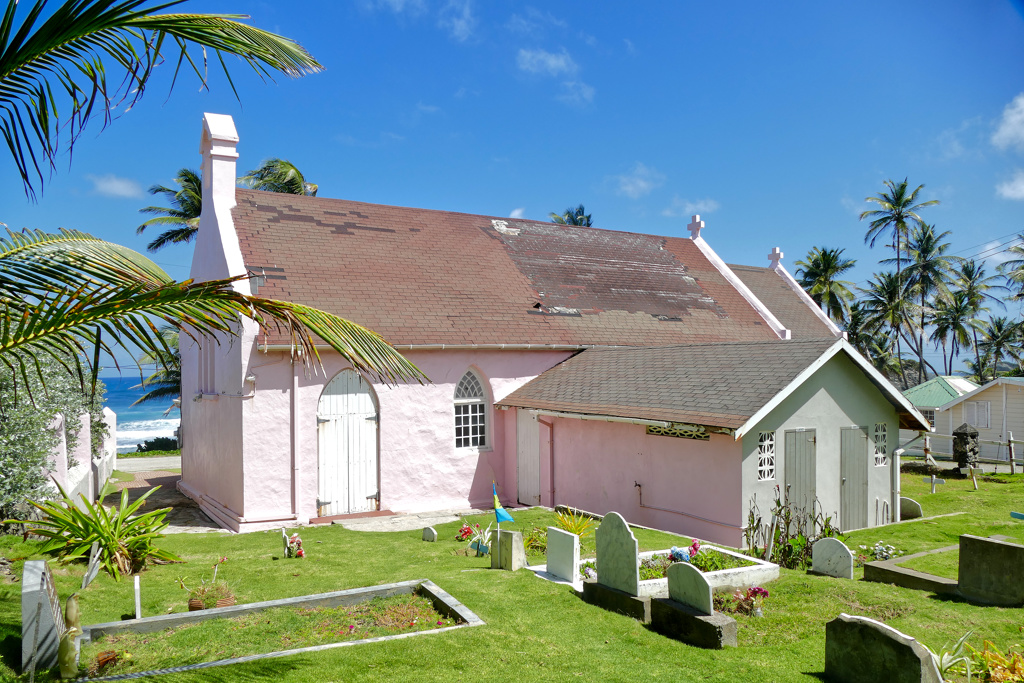
The main attraction of Bathsheba is undoubtedly the beach, known as the so-called soup bowl. Here, man-high waves break on huge boulders along the coast, creating a breathtaking spectacle. No wonder local and international surfing competitions are held here every year.
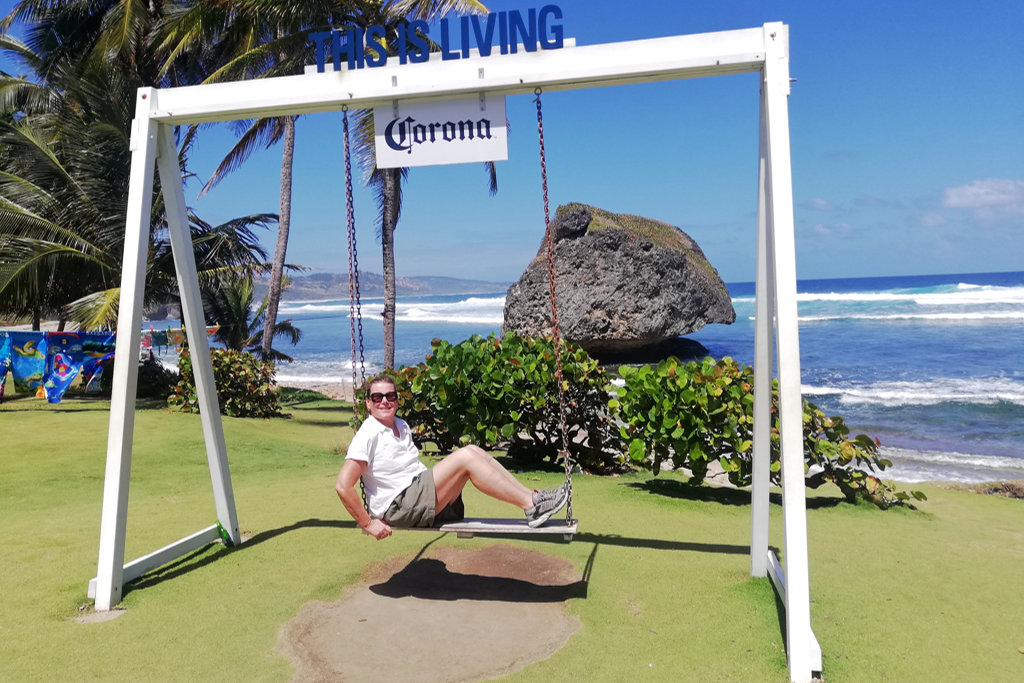
By the way, what at first glance looks like huge boulders washed up on the beach are actually rock formations that have broken off from an ancient coral reef!
Named After a Legend
But why Bathsheba? Legend has it that Bathsheba, the wife of King David, bathed in milk to keep her skin beautiful and soft. The white foam of Bathsheba’s surf is said to resemble this special milk. And indeed, the water here is rich in minerals that allegedly have health-promoting effects.
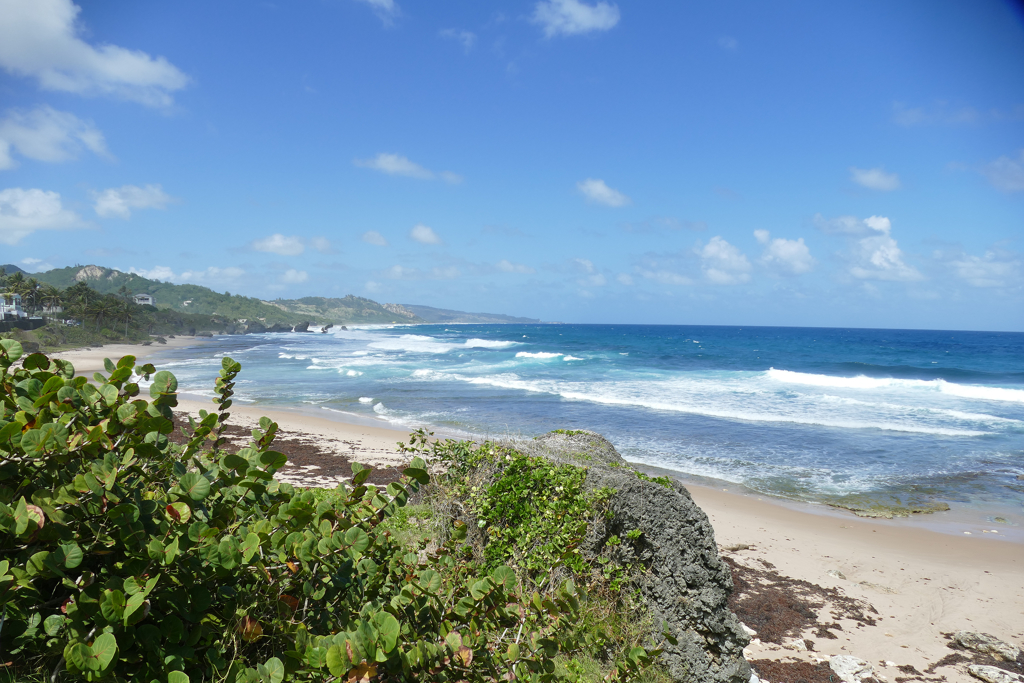
Swimming at Bathsheba is very dangerous as there are powerful rip tides and undertows. While it is tempting to walk into the ocean over the flat coral reefs, be extremely cautious, as incoming waves can pull you out to sea. However, soaking in the shallow inshore pools on a hot summer day is a favorite cool-off activity for many locals.
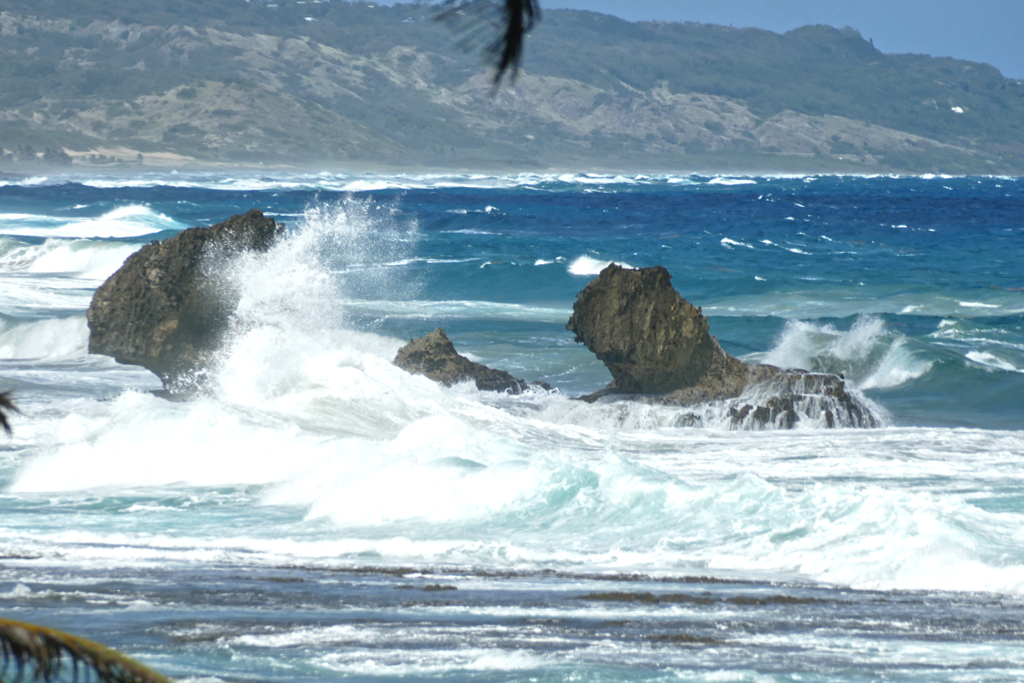
These pools are carved out of the inshore coral reef. They are several feet deep, and you can sit in them, enjoying a drink while the surf splashes in, swirling the water around in nature’s own whirlpool. A uniquely Bajan experience!
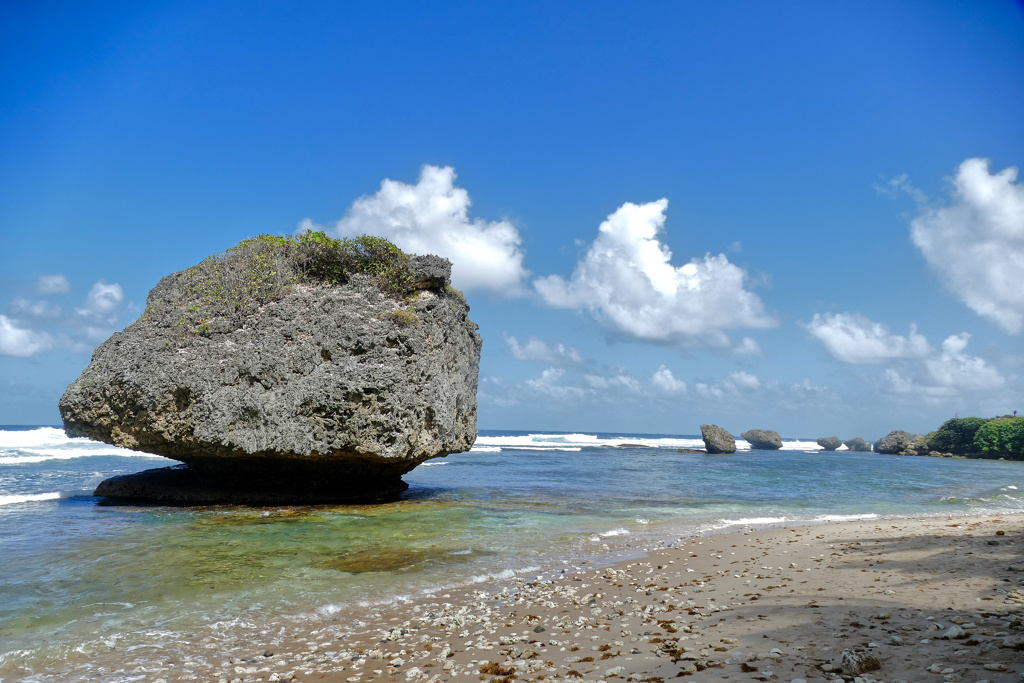
While the best way to get to Bathsheba is from the Nursery Drive Minibus Terminal in the east of Bridgetown’s center, places further south on the east coast, such as Bottom Bay and Crane Beach, are easily accessible from Oistins and the airport.
Trivia
On the northern edge of the city lies the ecologically rich tropical rainforest of Joes River. This is where the “Outer Banks” film set is located.
Sunbury Plantation House
The Sunbury Plantation House is one of the island’s most well-preserved so-called Great Houses. It offers visitors a fascinating look into Barbados’ colonial era.
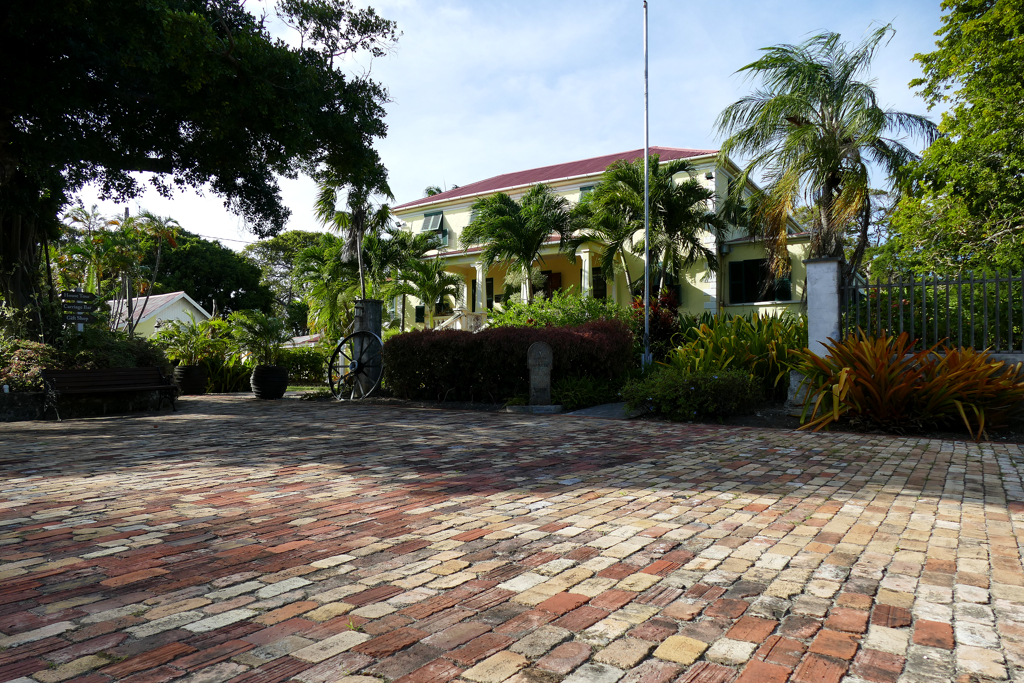
Built in the 1660s, it was originally owned by Matthew Chapman, an English planter who came to Barbados shortly after the island was settled by the British in 1627. Like many plantations in Barbados, Sunbury played a key role in the island’s sugar industry, which thrived on the labor of enslaved Africans until emancipation in 1834.
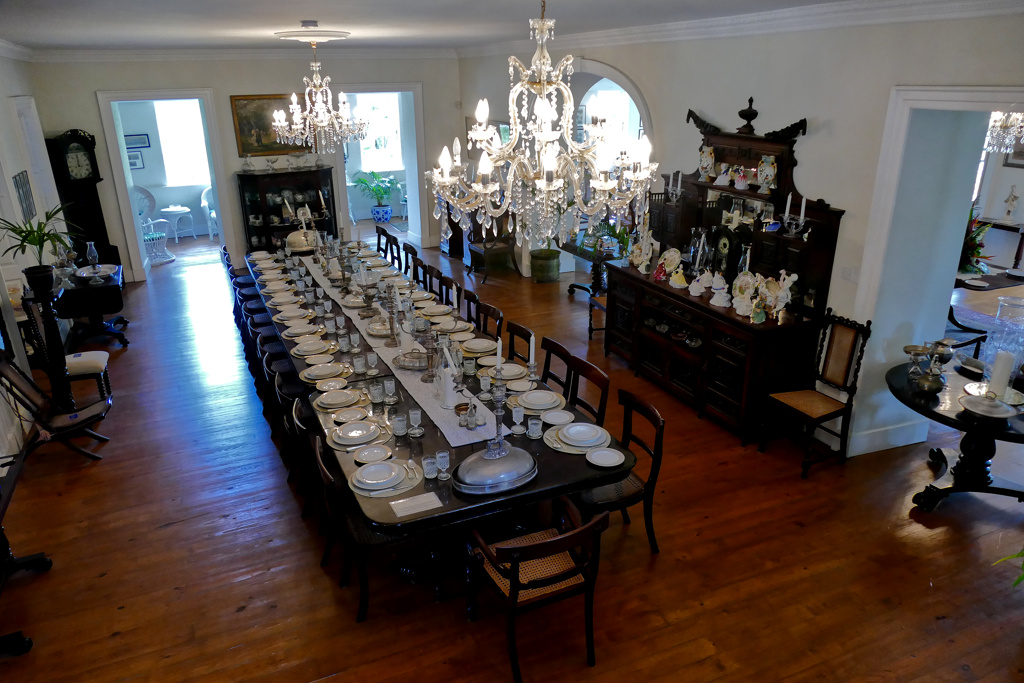
The house is constructed of thick coral stone walls and was built to withstand hurricanes. Yet, it has survived multiple fires and restorations over the centuries. Today, Sunbury stands out as the only Great House in Barbados where every room is open to the public, showcasing antique furnishings, mahogany furniture, and historic artifacts from the island’s early plantation days. Also, there is an impressive collection of horse-drawn carriages.
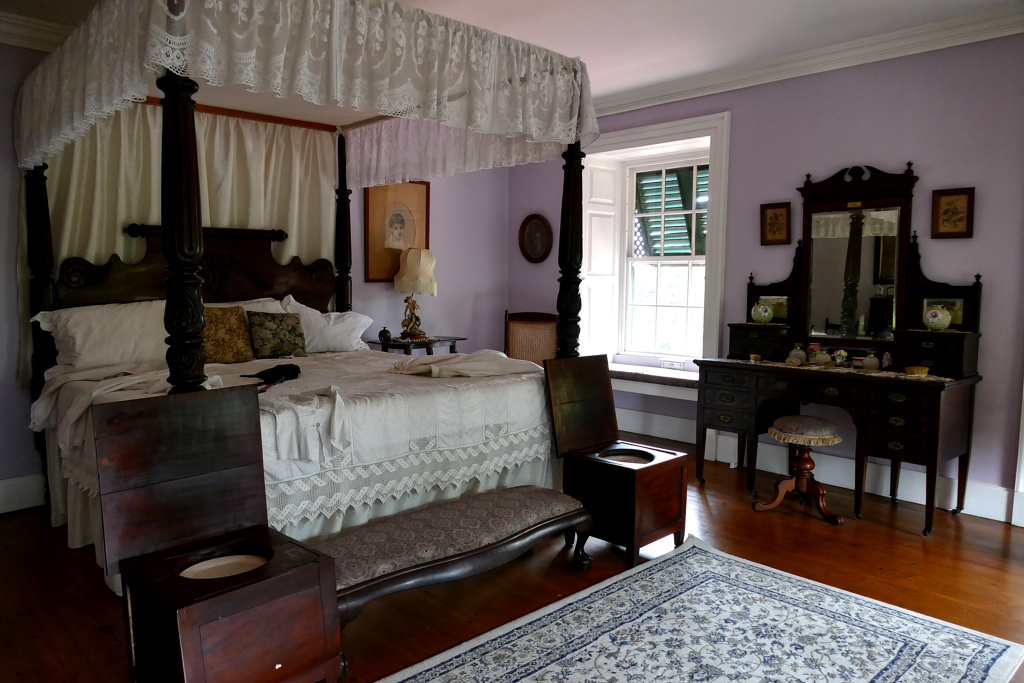
After the guided tour, you can enjoy refreshments or a traditional Bajan meal in their cozy courtyard or relax in the lush tropical garden.
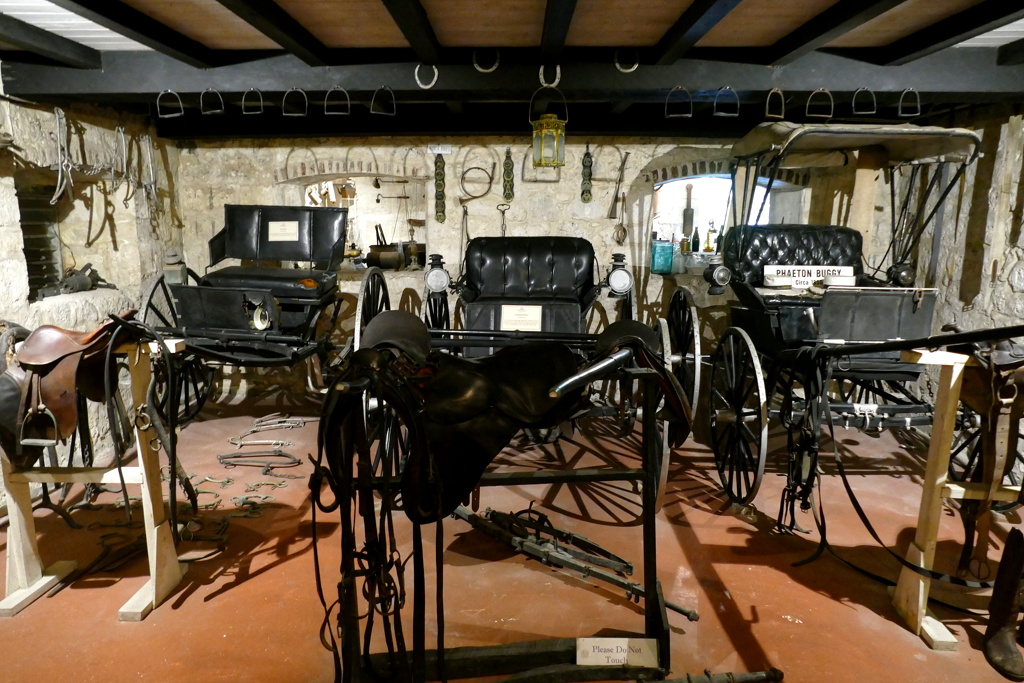
Plan Your Visit
Sunbury Plantation House is open daily, and guided tours run from 9 a.m. to 4:30 p.m., though hours may vary between May and October or when they are hosting special events. Therefore, it’s best to confirm before your visit. Admission for the house tour, which includes a complimentary drink, is very reasonable at 30 BBD. You can get to the plantation by public bus from Oistins in 30 to 40 minutes. As the bus toward College Savannah passes directly by the site, just tell the driver to let you get off right at the main gate.
Along the South Coast
The South Coast of Barbados is where the island’s laid-back Caribbean charm meets a vibrant social scene. Known for its white sandy beaches, turquoise waters, bustling nightlife, and a mix of local and international dining, the South Coast offers something for every traveler.
Obviously, Bridgetown is the best starting point for exploring the island by public transport. But the south coast is right after that, especially the western part facing Bridgetown. Outside of rush hour, the journey to the capital takes less than 20 minutes. Well, during rush hour, you can walk almost as fast as the bus, but that’s a whole different story.
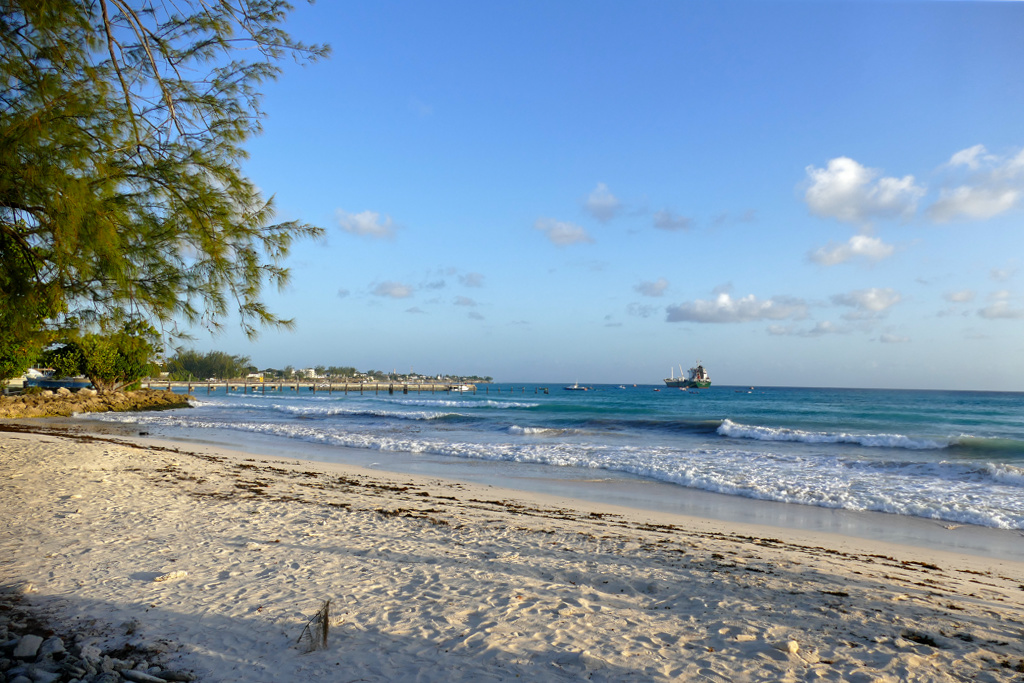
However, since I love to live in a quiet, non-touristy yet still easily accessible area, I think wide parts of the western south coast are the best base when in Barbados.
But as most of the time, it’s what you make of it. When I was in Aruba, everyone said it was terribly touristy and like Miami. That’s true for a certain area of Aruba, but I stayed in a completely different part, namely an authentic residential neighborhood. And that’s exactly how it was in Oistins. Of course, there are lots of big hotels where tourists get to experience the facilities and a certain section of the beach. If that’s what you go for, more power to you.
But you don’t have to do it this way. If you stay in a nice little apartment like I did, you can enjoy the benefits of the tourist infrastructure and still get a taste of real Bajan life.
Isn’t the best of both worlds always the optimum?
Oistins
However, Oistins is a place no visitor to Barbados can pass by. It is centrally located on the south coast and consists of a fishing village as well as a tourist area with a wide range of bars, rum shops, and strip malls, surrounded by some of the island’s most beautiful beaches.
Barbadian historian Richard Ligon believes that the term Oistins derives from the name Austin. Edward Austin was a landowner in the area and, according to Ligon, “a wild, crazy, drunken fellow whose offensive and extravagant behavior made him notorious on the island”. To this day, some tourists continue Austin’s extravagant lifestyle’n’legacy, particularly in the Saint Lawrence Gap entertainment district.
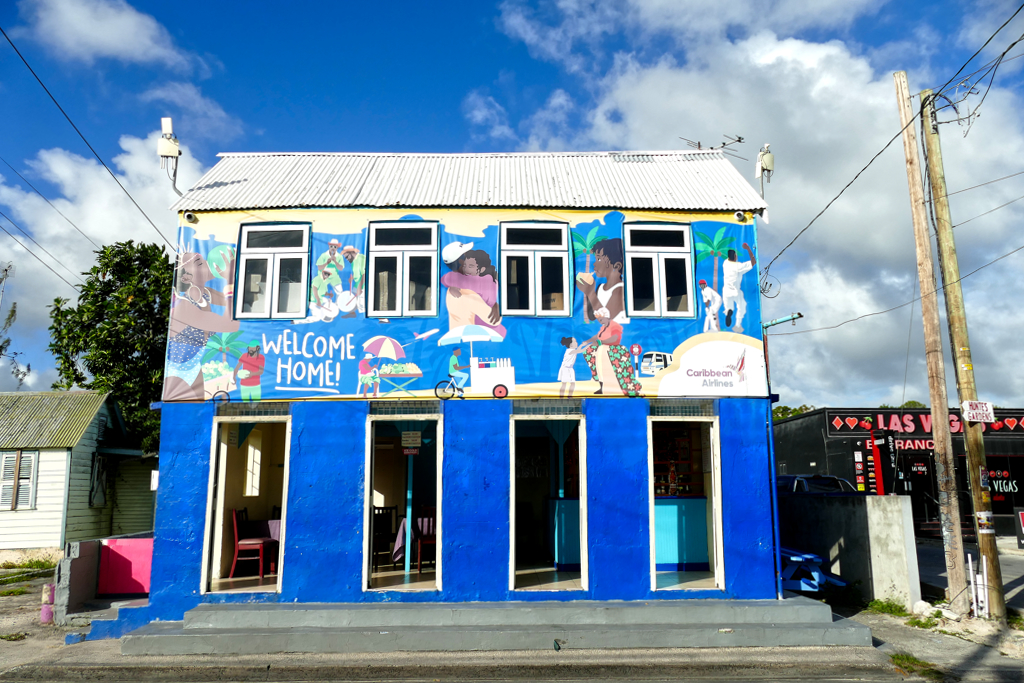
However, the boisterous tourist life is only one side of Oistins. For the most part, the place is an authentic, very relaxed settlement with many residential areas that remain completely unaffected and untouched by the large hotels, American fast food chains, and tourist infrastructure around them.
For King And Country
Also, the historical significance of Oistins should not be underestimated. After the defeat and execution of King Charles during the English Civil War in 1649, there remained Brits in Barbados who were resolute in their loyalty to the deceased King. Hence, Oliver Cromwell sent ships to invade the island to see what that was all about. After several unsuccessful attempts to invade Barbados at Speightstown’s port of entry, Cromwell’s fleet made its way to Oistins in January of 1651, where Governor Lord Willoughby commanded the forces to safeguard the island.
However, after a fearsome fight, the two men penned and signed the Charter of Barbados at the Mermaid Tavern in Oistins. This treaty provided Barbadian colonists with a guarantee that they would be able to control the local taxation and land ownership laws. Shockingly, the rights and privileges defined in that Charter remained in effect on the island up until its independence in 1966.
Fish, Fun, And Follies
Nonetheless, the little fishing village Oistins has preserved its friendly laid-back mode, and a visit to the Berinda Cox Fish Market and the adjacent food court Oistins Bay Garden is proof of this.
The fish market was named in honor of Berinda ‘Baby Doots’ Cox, who spent over 50 years in the fishing industry. It is open from Monday to Saturday between 7 a.m. and 9 p.m. These hours can vary slightly, so it’s advisable to visit earlier in the day for the freshest catch.
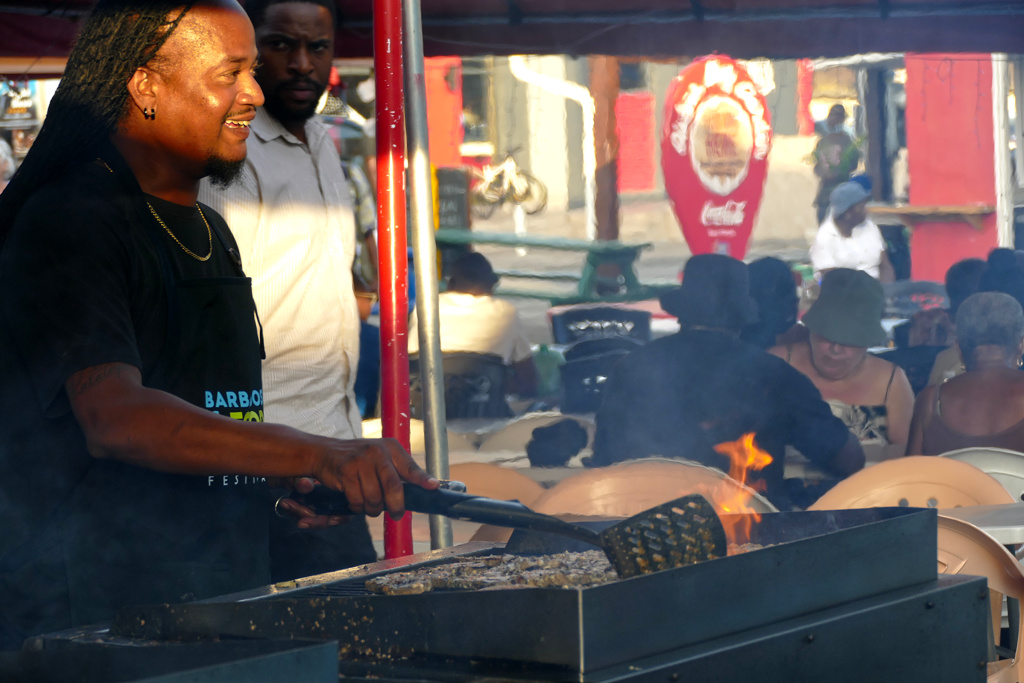
If you don’t have the possibility to do your own cooking while in Barbados, you can visit the Bay Garden next door. Many of the small restaurants are open throughout the day and well into the night. In general, all the menus consist of flying fish, tuna, mahi mahi, shrimp, and lobster, accompanied by rice and beans, Bajan macaroni pie, sweet potatoes, and different kinds of salads.
Fun fact
I was shocked when I first saw “Dolphin” on the menu!
What kind of barbarian would throw Flipper on the grill?
To my relief, the waitress laughingly explained to me that the locals call mahi-mahi dolphin.
The food isn’t exactly a bargain, but it’s good, and the portions are generous. I can recommend stopping at one of the little eateries in Oistins Bay Garden for a snack after a day on one of the nearby beaches. Nevertheless, I think the Friday Fish Fry is completely overhyped.
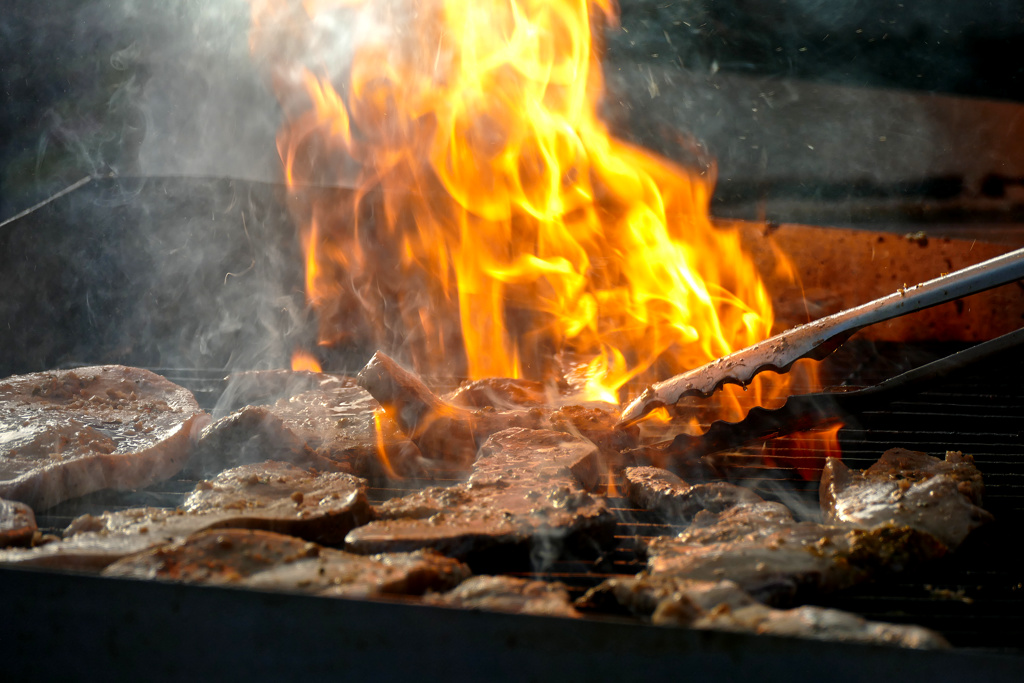
Yes, every Friday night, tourists flock to Oistins in a crusade to eat the exact same dishes that are available every other day. The difference is that on Fridays, you have to wait in long lines for your food. The Oistins Fish Fry is hailed on all channels as this authentic event where strangers become friends over a fish dish. In my experience, the Fish Fry caters primarily to tourists. Other than the working staff, I hardly saw any locals there on Friday nights. Bajans tend to come on Saturday and Sunday to play dominoes and sing karaoke. So, if you want to experience a real Bajan vibe at Oistins Bay Garden, better be there on a weekend afternoon.
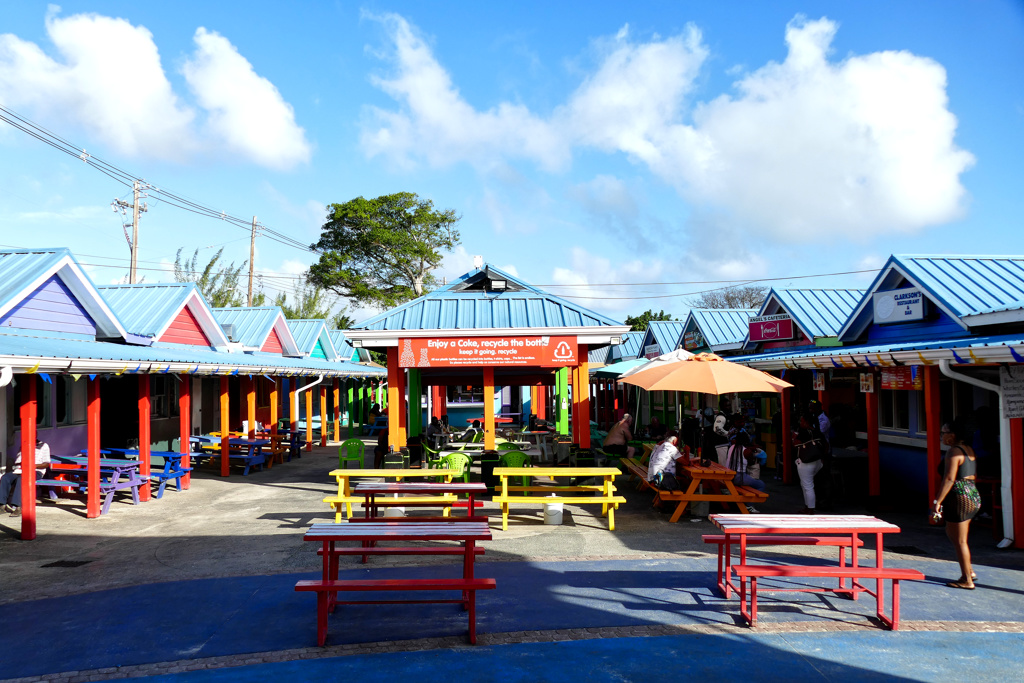
By the way, the extravaganzas in Oistins reach their absolute peak during the Oistins Fish Festival. It has been held annually during Easter week since 1967.
My Tip
Ask the fishermen at the market for fish scraps. You can then try to feed the turtles from the jetty to snap some great pictures.
East of Oistins
And as in virtually all parts of Barbados, the fabulous beaches around Oistins are the area’s greatest asset.
Directly adjacent to Oistins Bay Garden is the much-praised Miami Beach. Also known as Enterprise Beach, it consists of two quite different parts. Many claim that Miami Beach is one of the best beaches in Barbados, and I honestly don’t understand where that comes from.

The beach is relatively narrow and so crowded with sun chairs and parasols that you can barely find a decent spot for your towel if you don’t want to rent a chair. The waves and currents on the main beach are also extremely strong.
Behind a narrow headland is a more sheltered area where non-suicidal adults can swim and even small children splash around safely. However, in this part, there is hardly any sand. Of course, you can look for a place to lie down on the main beach and then go behind the headland for a swim.
Obviously, that’s not ideal.
As I said, I can’t understand the positive reviews of Miami Beach.

On the opposite side of Oistins Bay Garden is a less-developed row of beaches and bays. They are more secluded and far less frequented as there is no infrastructure on-site. Although I really like this section, I would only swim here on days when the waters are calm, as there is no lifeguard on duty.
Life is a Beach
Not too far west of Oisten’s town center, surrounded by larger hotels, is Dover Beach. You can compare it to Enterprise Beach: not very wide, full of loungers and umbrellas, and you should be very careful when swimming. The fact that even surfing beginners can have fun here says it all about the height and power of the waves. Also, there is a treacherous current.
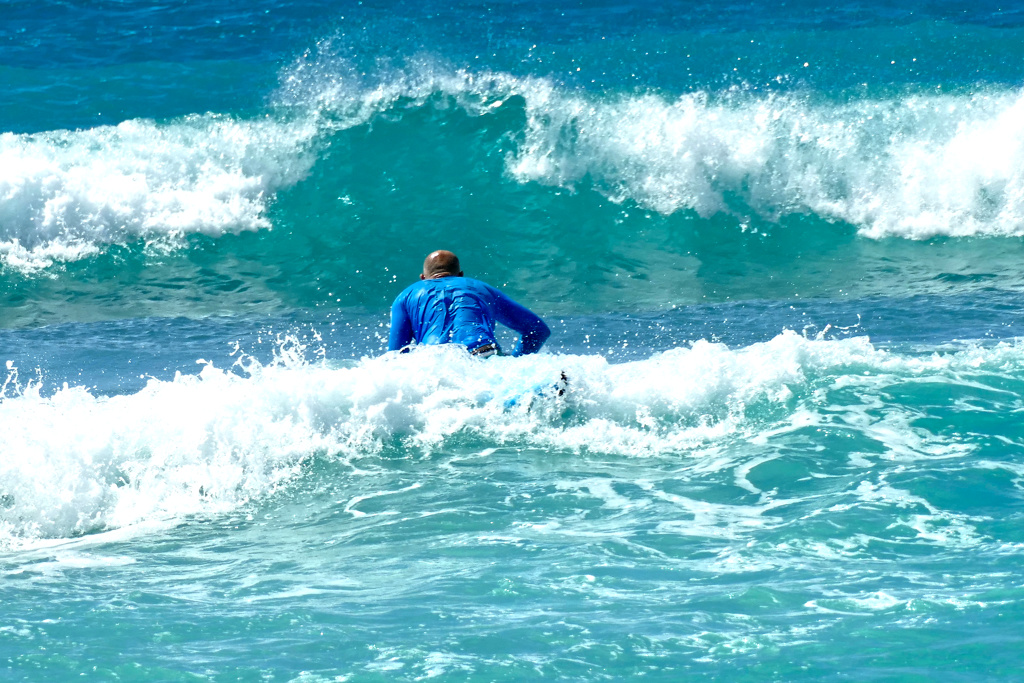
Dover Beach is also a hub of activity, with nearby bars, restaurants, and the popular St. Lawrence Gap just a short walk away. This ensures plenty of dining and entertainment options.
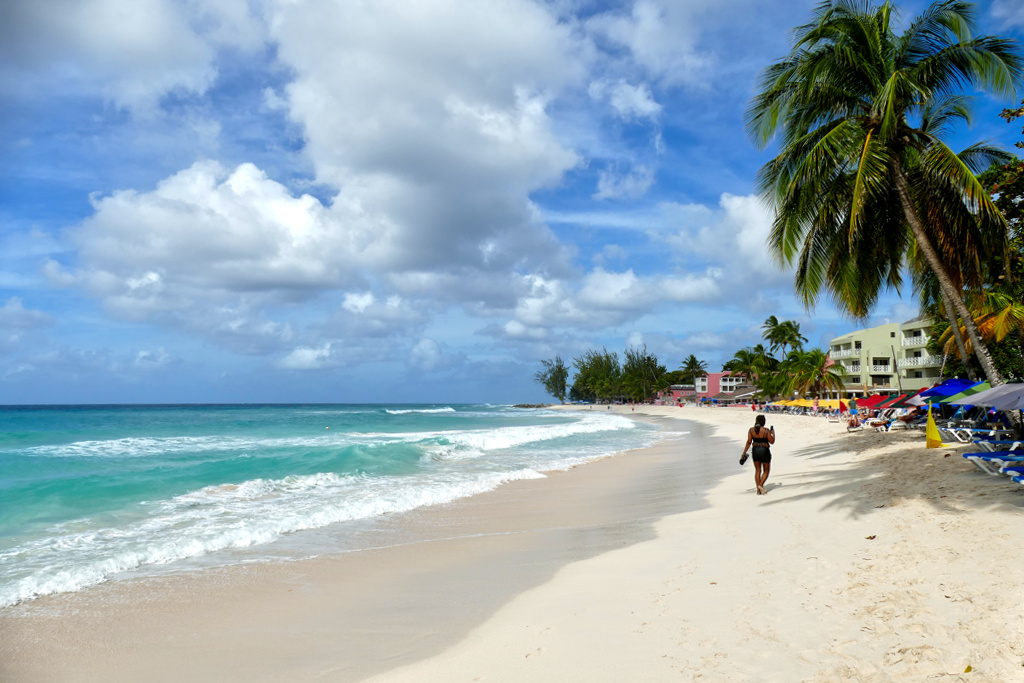
To the west of the St. Lawrence Gap, Worthing Beach stretches for about a kilometer in small bays. This beach offers plenty of space for paid loungers and umbrellas, but also enough pleasant sunny and shady spots for those who bring their own beach equipment. There is a particularly nice and relaxed atmosphere here.
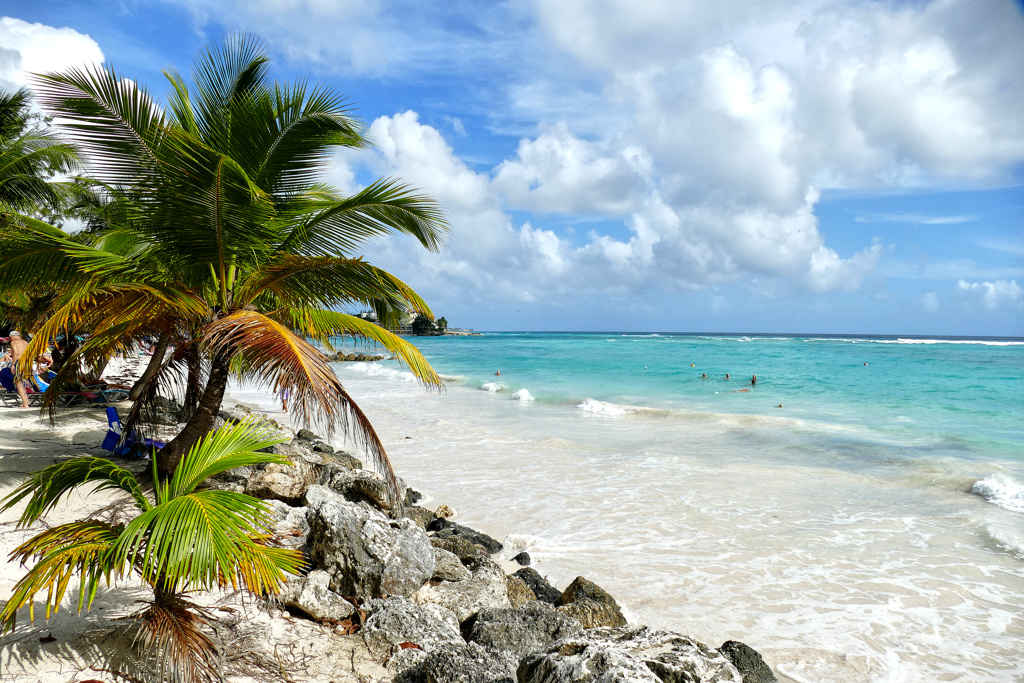
For me, Worthing Beach is by far the best beach on Barbados’ south coast.
Getting Busy
The next bay is also very beautiful and offers plenty of space for personal beach equipment in addition to the umbrella renting businesses. This makes Rockley Beach, also known as Accra Beach, one of the most popular beaches on the south coast. This stunning stretch of beach with soft, slightly pink sand and turquoise waters offers something for everyone. Bodyboarders and surfing beginners can certainly count on high waves and strong currents. At the eastern tip, however, nature has created a calm, shallow pool where the less daring can swim quietly and safely.
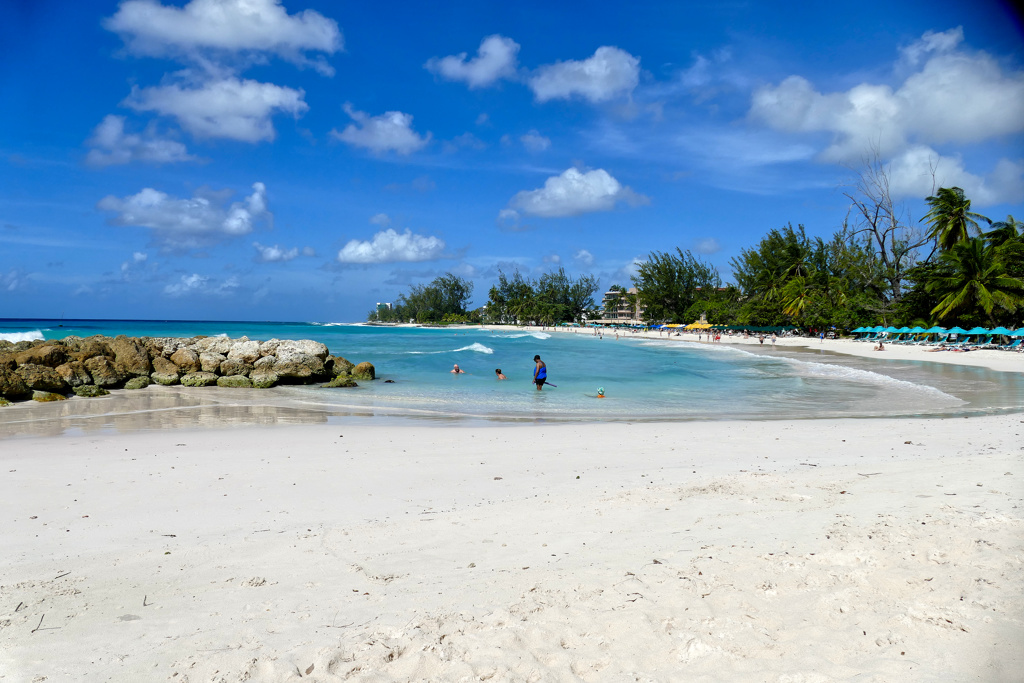
A highlight of Rockley Beach is certainly the lively Richard Hayne’s Boardwalk, which runs along the coast and offers stunning sea views as well as access to cafes, bars, and shops. Street vendors sell everything from refreshing coconuts to handmade crafts, adding to the lively atmosphere.
On a Personal Note
Note that most beaches in Barbados have amenities such as sun loungers and parasol rentals, changing rooms, public toilets, and freshwater showers. The standard price for a lounger and a parasol is 10 BBD each. However, they are totally fine with it if you rent just the chair and place it in the shade of a tree.
Also, nobody gave me a mean look because, as a solo traveller, I only needed one chair. Sadly, I had a different experience in many other countries, where they only allowed to rent a set of two chairs and an umbrella – in addition at exorbitant prices.
Practical Information
How to Get There
The Grantley Adams International Airport is located about 16 kilometers southeast of Bridgetown. Visa requirements vary depending on your nationality. Visitors from the US, Canada, Europe, and the UK can stay visa-free for up to 6 months. However, all visitors must complete an online Immigration & Customs Form before arrival.
Some hotels and all-inclusive resorts offer free or paid shuttles, you should check that with your accommodation in advance. But even if you are on your own for the onward journey, you won’t get stuck.
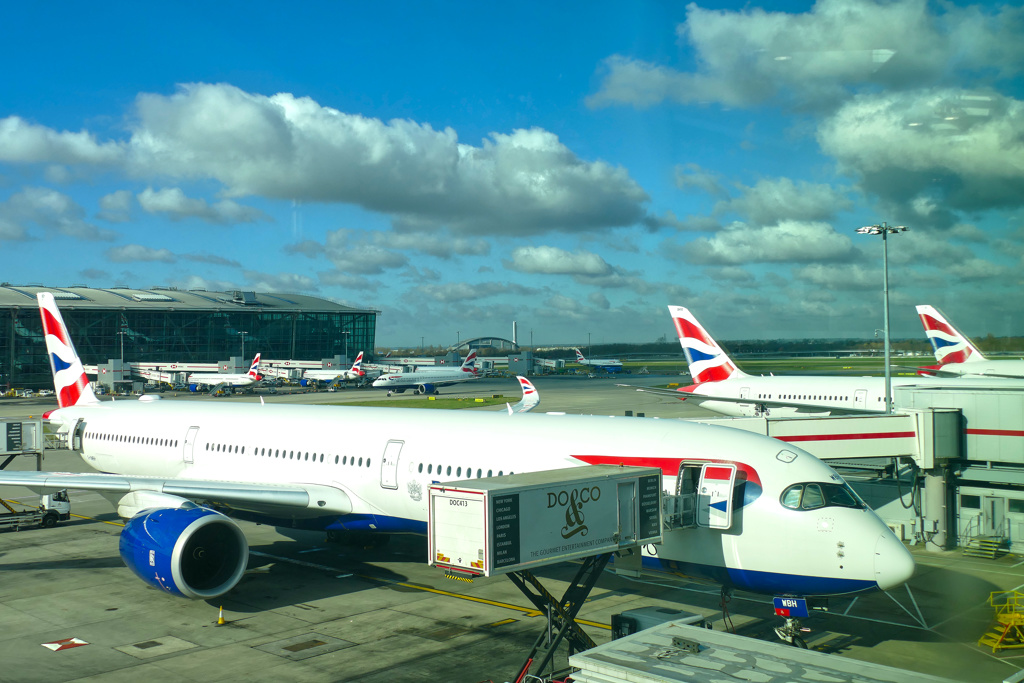
If you are driving, you’ll find various car rental companies right at the airport. All you need is a temporary local driving permit, which the rental agency will issue on-site. Especially during high season, pre-booking of rental cars is highly recommended. Also, keep in mind that
driving in Barbados is on the left side.
If you want to take a cab, note that there is a fixed-rate service available outside the terminal. However, confirm the price with the driver. It was very strange that I paid 30 BBD to get from the airport to my apartment in Oistins but couldn’t find a driver to take me back to the airport for less than 55 BBD. If someone knows what this is all about, I’d be grateful to know.
Finally, there is also a bus stop within a short walking distance from the airport. While paying only 3.50 BBD is an amazing option for budget travelers, it will be a bit of a hassle if you have bulky luggage.
Note that there is no Uber in Barbados.
To Feel the Soul of a Country, Take the Bus
Supposedly, the bus from Oistins to Speightstown takes 40 minutes – where in God’s name does the internet get that from? To make it in 40 minutes, you have to drive the route at 4 a.m. when the roads are empty and the island is in a deep sleep; except for the notorious roosters. At any other time of the day, you should allow up to two hours for the 28 kilometers to be on the safe side. If it goes a little bit faster, good for you!
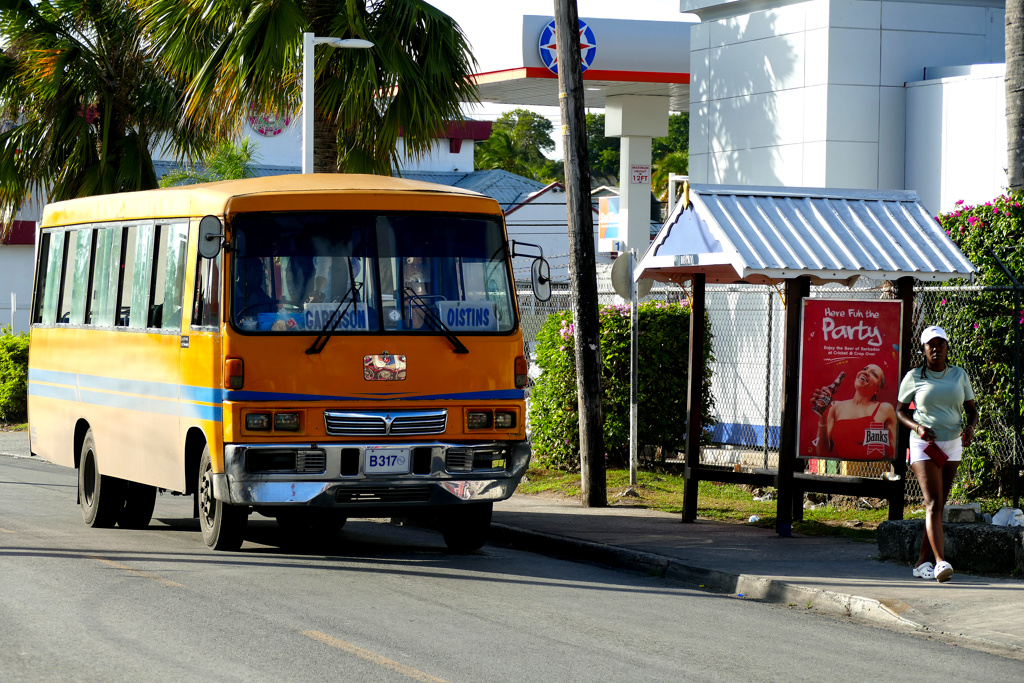
The bus system in Barbados is good and comprehensive. Everyone likes to use it, as you can see by the occupancy of the bus in which I sit, sandwiched between a neatly dressed lady on the way to work and a window pushed open for ventilation. In my lap, I’m not only holding my small daypack but also a schoolgirl’s huge, very heavy backpack. This is common courtesy: the lucky ones who get a seat take the burden off those standing. Literally. And so, a bag full of knowledge weighs heavily on my knees and squeezes the blood from my thighs.
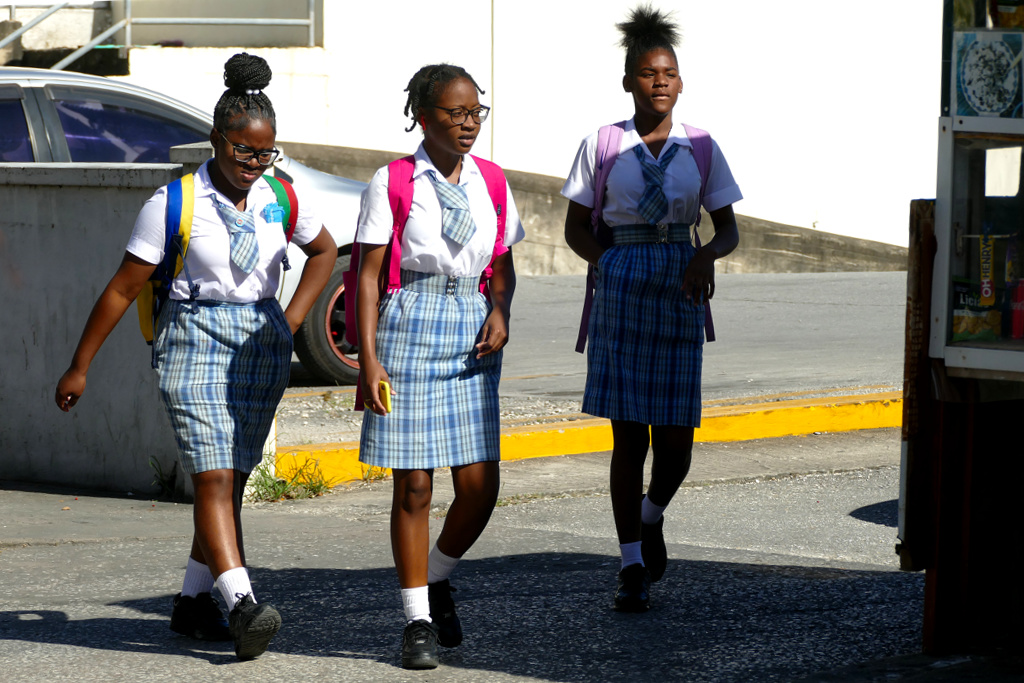
“Move to the back”, orders the conductor, shouting. He’s assisting the driver by ushering people and collecting the fare: 3.50 Dollars from adults, school children only pay 2.50 Dollars. Barbados Dollars, that is. In US currency, it’s half. The man means well because other passengers want to get on. But the people are standing squeezed together, it’s impossible to move any further back.
The Way is the Goal
Not only do the passengers stand, but unfortunately, the bus does too. Or at least close to it. Because not only are the buses congested, especially in the morning and afternoon, but so are the streets. When things finally start moving forward, they only do so at a walking pace. This means there is no breeze coming through the open windows, so it’s getting painfully hot. Minutes become an eternity. If I wasn’t only halfway there, I would be faster on foot. It reminds me of Lima, where those in a hurry preferred to get out of the bus and walk the rest of the way.
As I said, my final destination is, unfortunately, too far away for this appealing alternative. Again, we advance a bit at a walking pace. Our progress is so slow that the driver has a chat with a lady walking next to the bus. Nope, I’m not making this up!
At some point, we are out of this bottleneck, and things continue at a brisker pace. I check the time on my phone: I left an hour ago, and we’re only halfway there.
Again: Where did the internet get the information that it would take 40 minutes to cover the entire route?
How to Get Around
Despite my little rant: Public transportation in Barbados is comprehensive and thusly an affordable and efficient way to experience the island’s diverse attractions and local culture.
Seriously, I don’t understand why, for instance, Guadeloupe, Martinique, or Bonaire don’t follow this environmentally and population-friendly example. If you don’t have a rental car on those islands, your greatest adventure will be getting from A to B.
It’s pathetic!
Barbados, however, has a pleasantly extensive public transportation system that makes exploring convenient for everyone. The net comprises government-operated buses, privately owned minibusses, and shared cabs, so-called ZR vans. The standard fare on either of these vehicles is 3.50 BBD per trip. You can pay in local currency or US Dollars. However, most of the time, you’ll get change in Barbados Dollars.

Buses operated by the Barbados Transport Board are big’n’blue, minibuses are orange, and ZRs are beige with a brown stripe. Although they all charge the same, there are some important differences. While the driver or collector at the privately-operated coaches will give you change, you have to put the exact fare into the big bus’ money box, and no change is provided.
Also, the blue buses stop only at designated stops, while you can ask at least the ZR drivers to let you get off where it’s most convenient for you. Generally speaking, a ride in a ZR becomes quickly a folkloristic experience: whether the driver stops briefly in a village to purchase some weed along the way or he turns around as he gets a phonecall just to pick up a girl who didn’t get to the bus stop in time, anyone who takes a ZR is in for far more than just a busride.
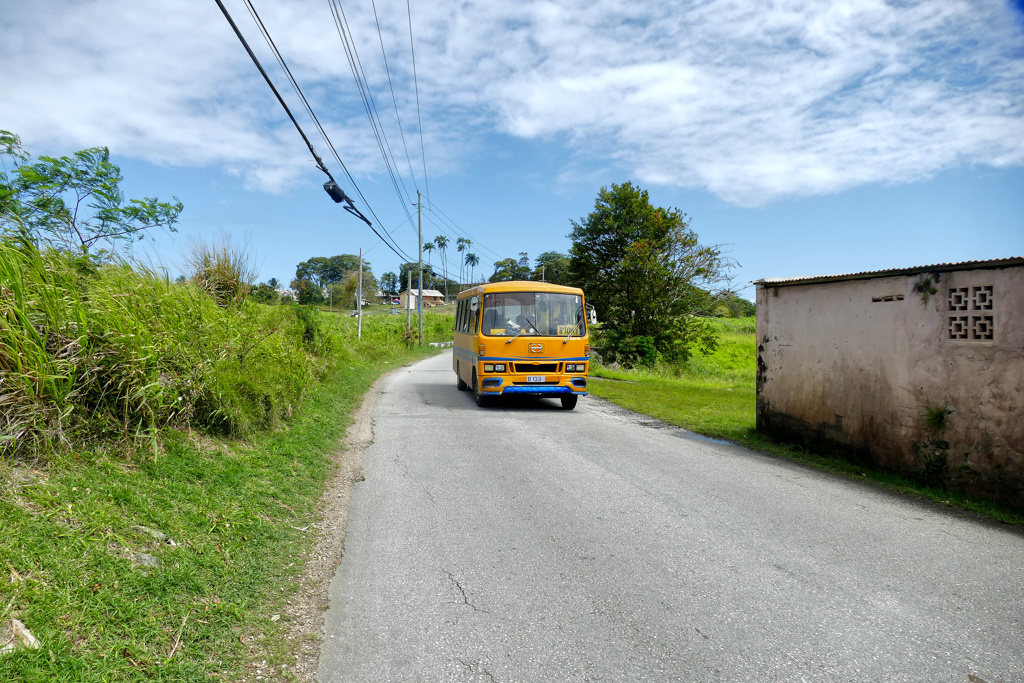
While government buses have fixed schedules, minibusses and ZR vans operate more often and far more flexibly. On the other hand, the privately organized means of public transportation do not operate on weekends on certain less-frequented routes. Take that into consideration when planning excursions by public bus.
Stay Flexible
Knowing all this is fine and dandy, however, it’s not easy to figure out a schedule online. The Transport Board’s website sorts the buses according to numbers. That’s okay for guiding a true connoisseur of the system, but not a visitor who needs basic directions. Evidently, they don’t inform on minibuses and ZRs on their website.
Unfortunately, my all-time go-to app, Google Maps, is also useless when it comes to public transport in Barbados. Hence, I actually found out that the Apps Rome2Rio as well as Moovit are adequate tools for figuring out bus connections. The greatest help, however, are the friendly and helpful locals, obviously.
Organized Trips
Although the public bus system in Barbados is not bad at all, there are places that are more difficult to reach. Especially if you are on the island for only one or two weeks, joining an organized day tour is a great option to save time and still get to see a lot.
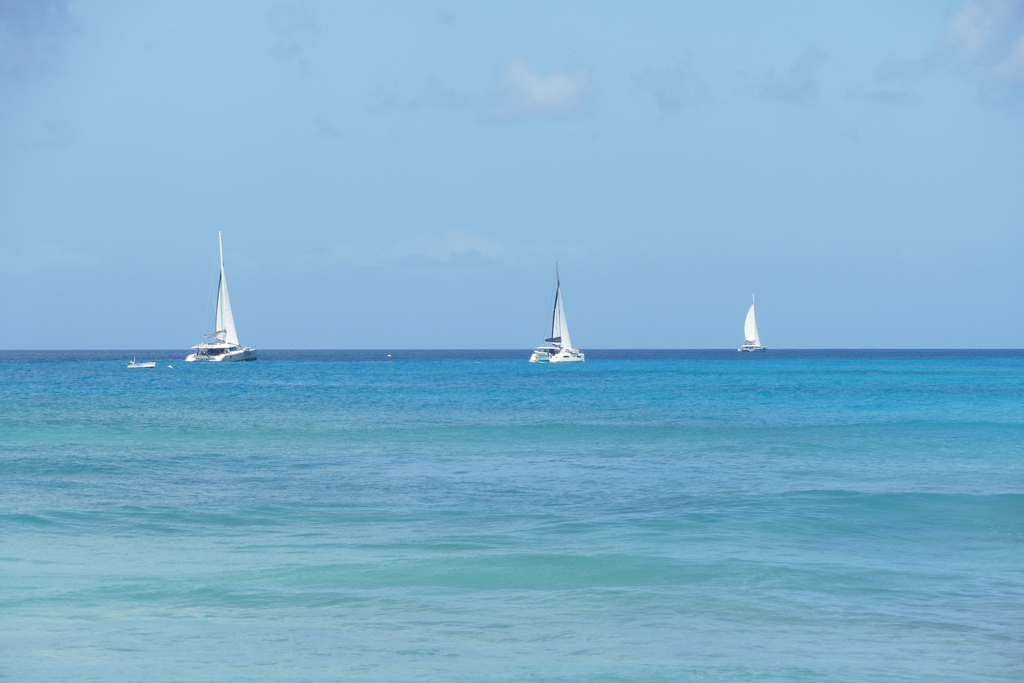
Also, you’ll presumably need to join an organized tour if you want to engage in activities on the water, like sailing or snorkeling from a boat. Therefore, check out these organized trips’n’tours*:
Where to Stay
Since tourism is one of Barbados’ main industries, there are many kinds of accommodation to choose from. However, most visitors come on a standard holiday package, which includes a stay at one of the large resorts. Obviously, this kind of tourism drives up prices. Finding budget-friendly yet convenient accommodation in Barbados is not always easy.
Nevertheless, for my stay, I chose an apartment in a residential part of Oistins within walking distance of Dover Beach. Since I’m not driving, I also wanted to be within walking distance of the bus station so that I could explore the island by public coach.
There are tons of very different lodging options in the area, and here are some suggestions*:
What to Eat
Bajan food is a vibrant fusion of African, Caribbean, British, and Indian influences. Rooted in fresh seafood, locally grown produce, and a rich blend of spices, Bajan dishes offer a unique and flavorful experience.
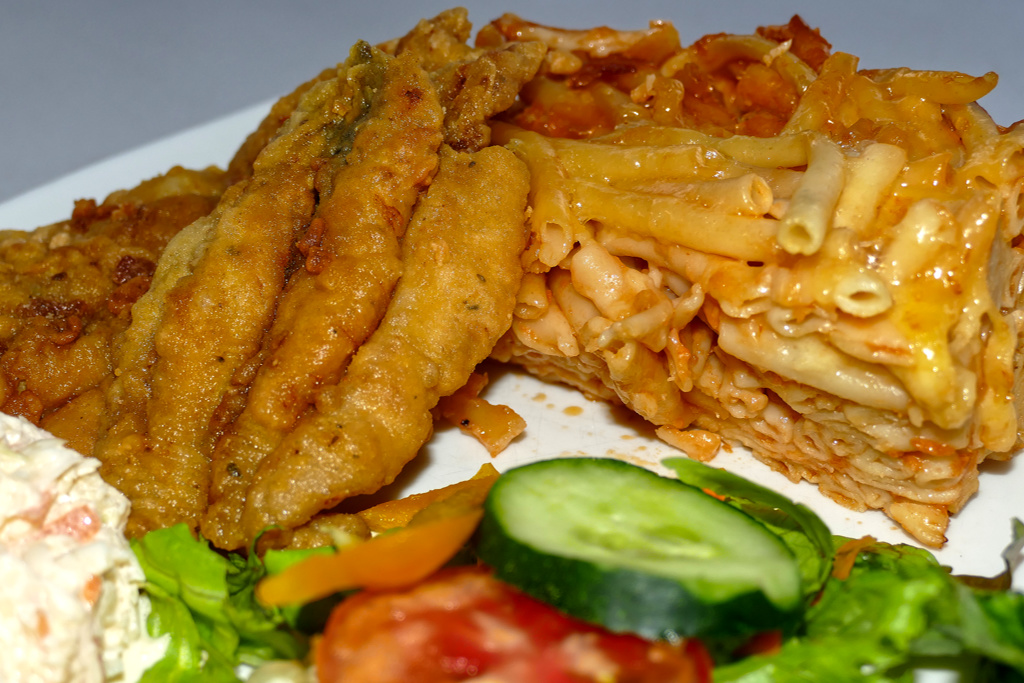
Among the must-tries is the national dish, Flying Fish and Cou-Cou. Here, delicately prepared flying fish is accompanied by a polenta-like mixture of cornmeal and okra. Albeit, comfort food lovers will eat their flying fish rather with a side of Macaroni Pie. Another local favorite is Pudding and Souse, a traditional dish featuring pickled pork paired with spiced sweet potato pudding. Hearty meals like Pepperpot, a spicy stew made with pork, beef, and a medley of spices, showcase the island’s love for bold flavors.

Street Food
Barbados is known for its street food. Vendors serve deep-fried, crispy Fish Cakes with a generous drizzle of Bajan pepper sauce. For a crunchy snack, Breadfruit Chips, similar to potato chips but with a more nutty flavor, are a delicious local treat. Cutter Sandwiches, made with salt bread and stuffed with fillings like flying fish, ham, or cheese, are a quick and satisfying snack. The most delicious of these wonderful treats are often sold straight from the back of a pickup truck on the side of the road.
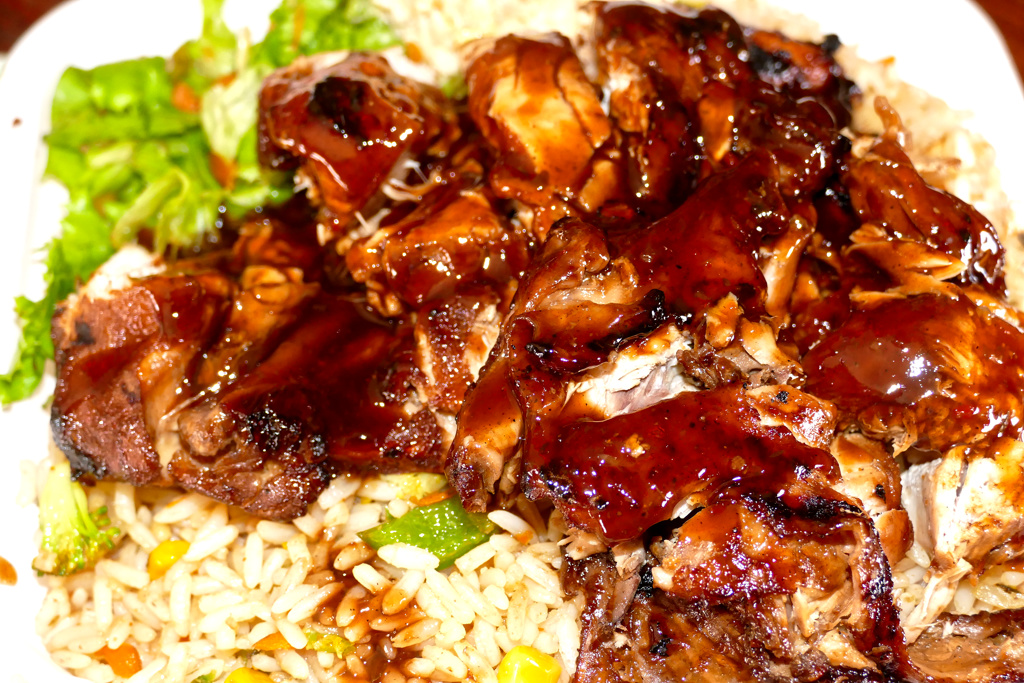
In addition to traditional Bajan cuisine, there are also culinary imports from the other Caribbean islands, such as Jerk Chicken from Jamaica and Buljol from Trinidad. Also, a highly popular dish is Roti. This dish based in Indian cuisine consists of a soft flat bread that is then filled with curries.
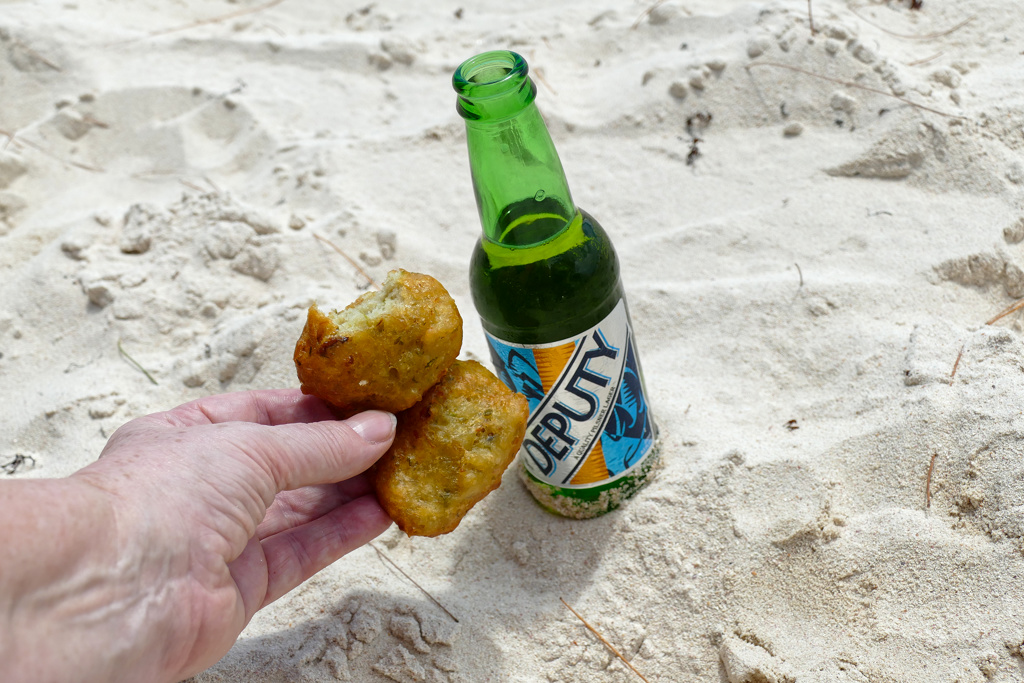
Finally, you can also get Italian food like pizza and Mexican food like tacos in many eateries across the island.
With such a rich selection of exciting dishes, I just can’t wrap my head around how much US fast food has made its way to the island. Why do people come to Barbados when they want to eat at Burger King or KFC? Have I missed something? Isn’t part of travelling to try local dishes? Obviously, not for everyone. However, if you can’t do without burgers and fries, at least try those from Chefette, a local fast food chain that stands out as a homegrown favorite. Its blend of local flavors and commitment to the community has solidified its status as a Barbadian institution.
What to Drink
No culinary experience in Barbados is complete without sampling its drinks. Mauby, a refreshing local drink made from tree bark, has a unique bittersweet taste, while Sorrel Punch, made from hibiscus flowers and spices, is a festive favorite. Obviously, local rum – whether pure or in a mixer – is a must.
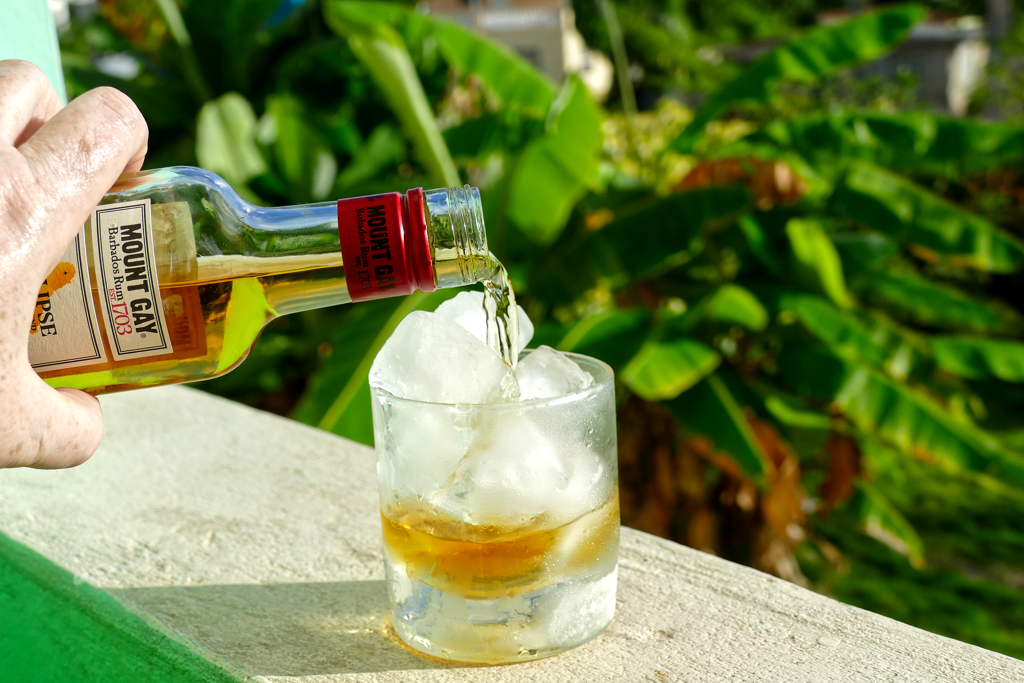
Last but not least, the info that Barbados’ tap water is drinkable. I find it quite ironic that many visitors from the US, where the tap water tastes as chlorinated as if you are drinking straight from a swimming pool, are suspicious of the quality and prefer to buy the overpriced bottled water.
Don’t do that. Bring your drinking bottle and fill it with tap water. It’s free. It’s good for you. And it’s good for the environment as we save those nasty plastic bottles.
Cash And Cards
The Barbados Dollar is the island’s official currency. It is abbreviated BBD. However, you can pay with US Dollars in most places, even on the bus. Although many places allow you to pay with credit or debit cards, some places only accept them with a minimum amount.
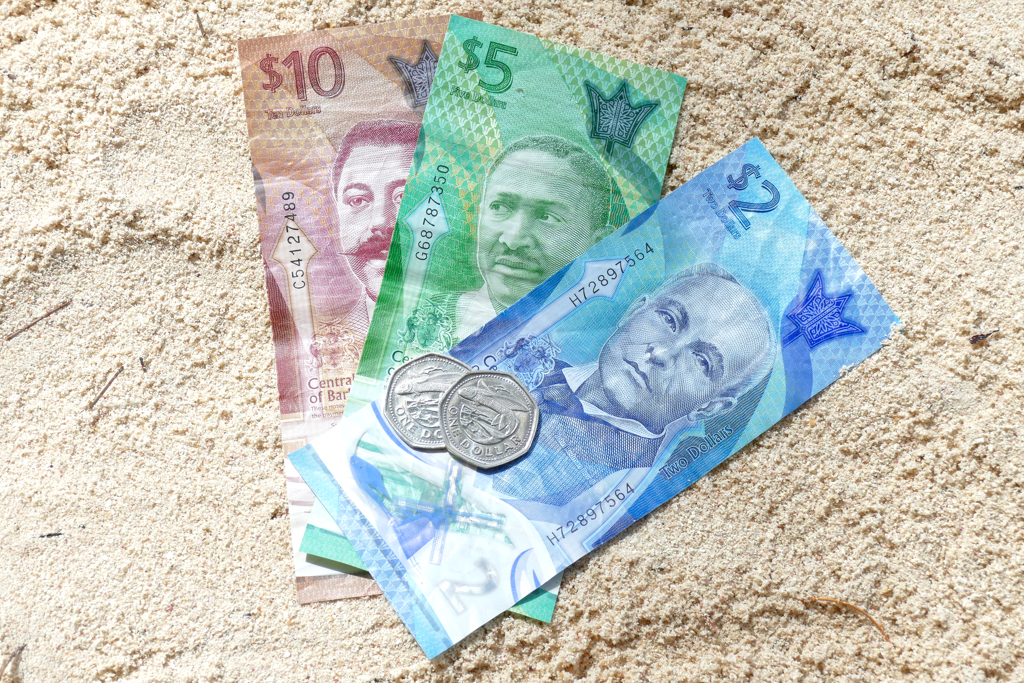
The fixed exchange rate is 1 USD to 2 BBD, which makes things really very easy.
Language
Barbados was a British colony, hence, the official language is English. Regardless, the most widely spoken tongue in daily life is Bajan Creole, an English-based patois with influences from West African languages, brought by enslaved Africans. It has a unique rhythm, pronunciation, and slang. This makes Bajans basically bilingual as they are switching between English and Bajan Creole depending on the context.
Connection and Communication
First things first: As all accommodations and many restaurants, landmarks, and other places offer free Wifi, I daresay that you don’t need a data plan. Since it was my first time in Barbados, I was travelling solo, and explored the island by public transport, I simply felt safer having access to the internet also on the road. However, if I return to Barbados, I probably won’t spend money on a local SIM card.
This being said, I was very happy with my Digicel card. I opted for data only since I had no intention of making phone calls. Also, online calls are a valid alternative.
The SIM card cost me 15 BBD, and as I opted for a two-week data plan including 12 GB, I paid another 55 BBD. However, they have many different plans, from 500 MB for one day for 5 BBD to 20 GB for 30 days which sets you back 85 BBD. You might want to check out all the options on their website.
Tourist Plan
However, there is also a prepaid Visitor plan including calls, SMS, and data with the following key data:
| Days | Calls Anywhere | SMS | Data | Price |
| 7 | 250 minutes | 100 | 8 GB | 60 BBD |
| 10 | 150 minutes | 500 | 12 GB | 80 BBD |
| 30 | 800 minutes | 200 | 30 GB | 200 BBD |
Don’t forget to unlock your phone so that you can insert any SIM card. Alternatively, you can use an eSIM, obviously
In Barbados, they use plug types A and B. The voltage is 115 V and the frequency 50 Hz. As long as you have the right connecting plug, the voltage and frequency shouldn’t really matter as nowadays, all chargers have integrated adapters.
By the way, you’ll find comprehensive travel info in my post World’s Most Complete Travel Information – an indispensable globetrotter-classic.
Map
This map shows where all the mesmerizing places I’m introducing in this post are located.
Clicking on the slider symbol at the top left or the full-screen icon at the top right will display the whole map, including the legend.
Do you want to learn more about the capital, Bridgetown, or know which beaches are the most beautiful and how to get there by public bus? No problem, you’ll find all relevant info in these posts:
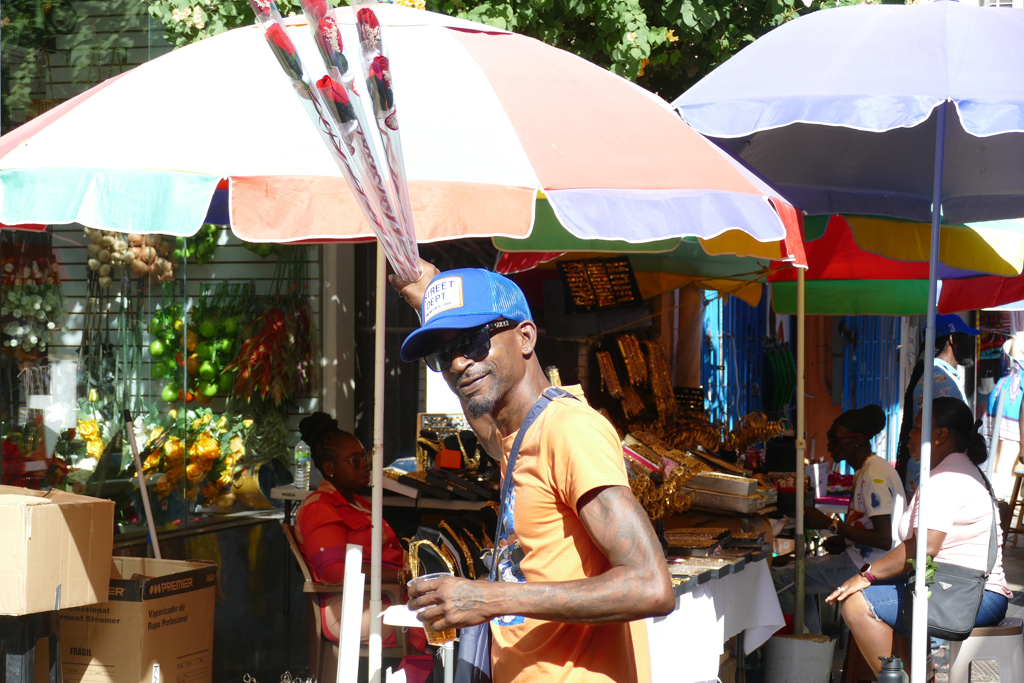

Pinnable Pictures
If you choose to pin this post for later, please use one of these pictures:
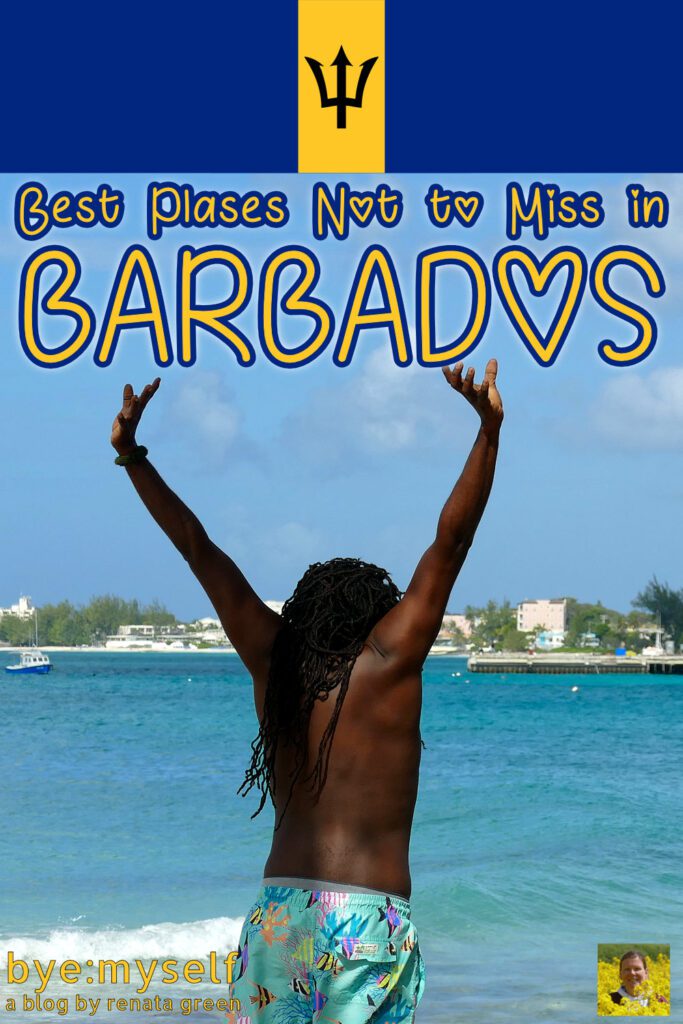
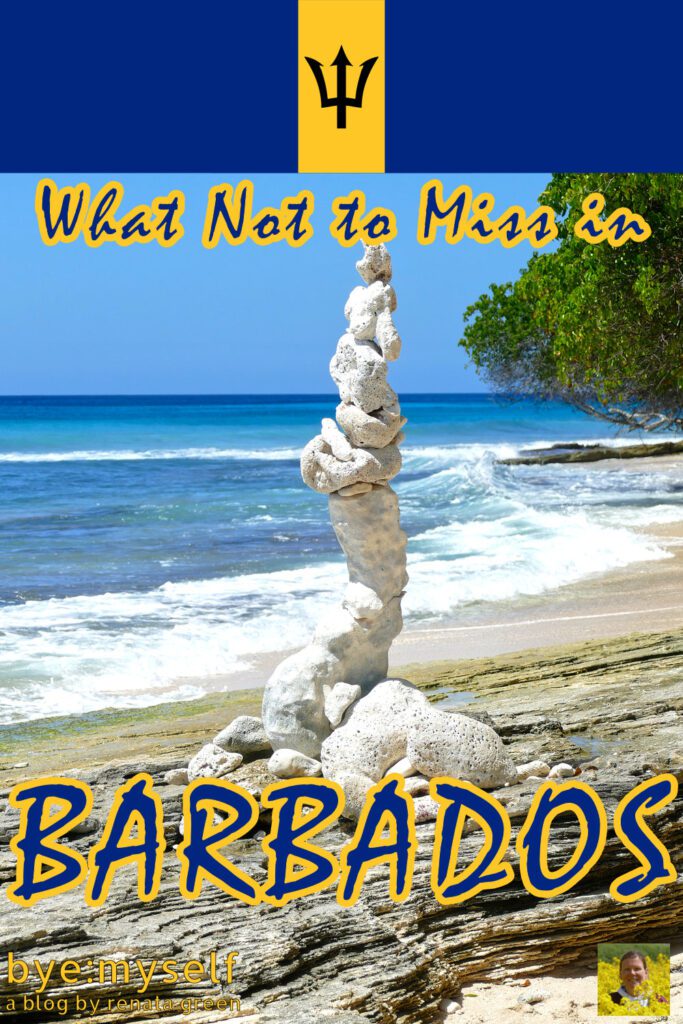
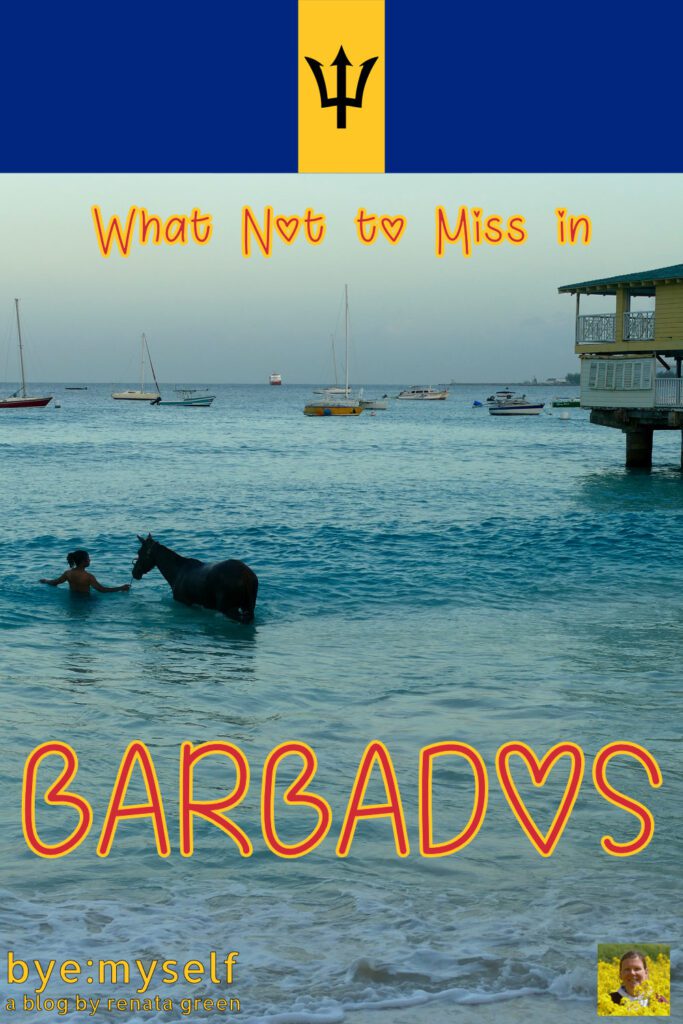
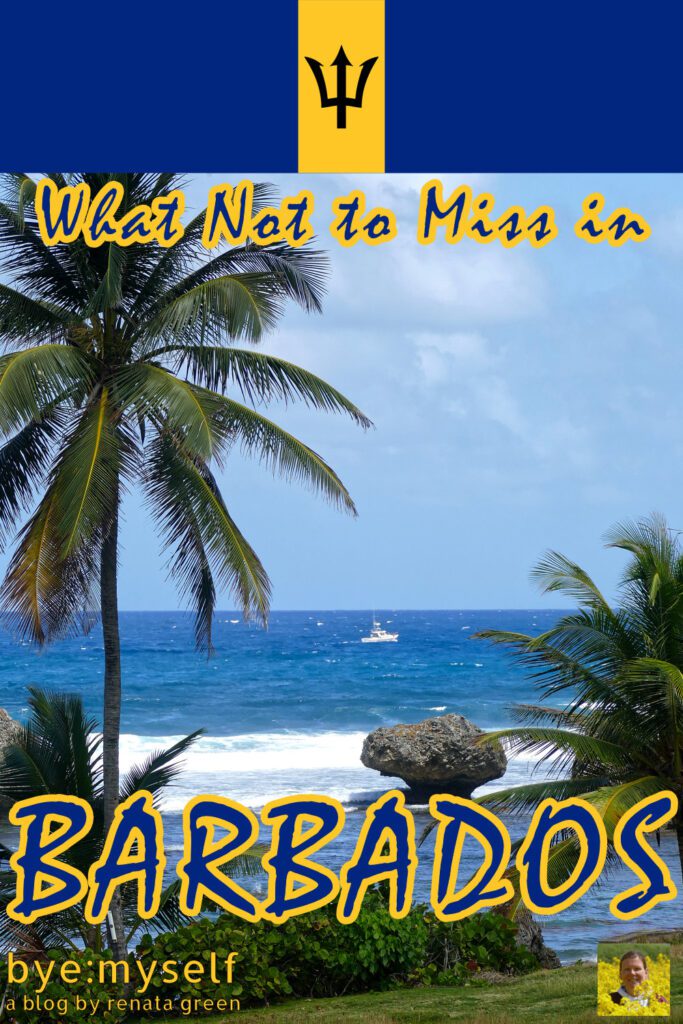
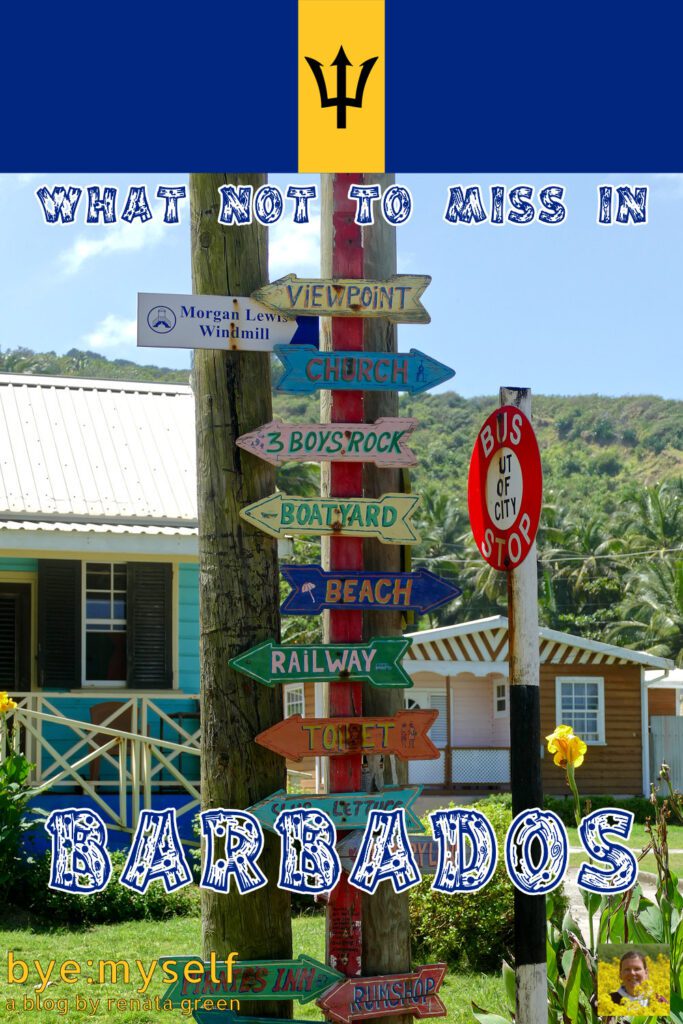
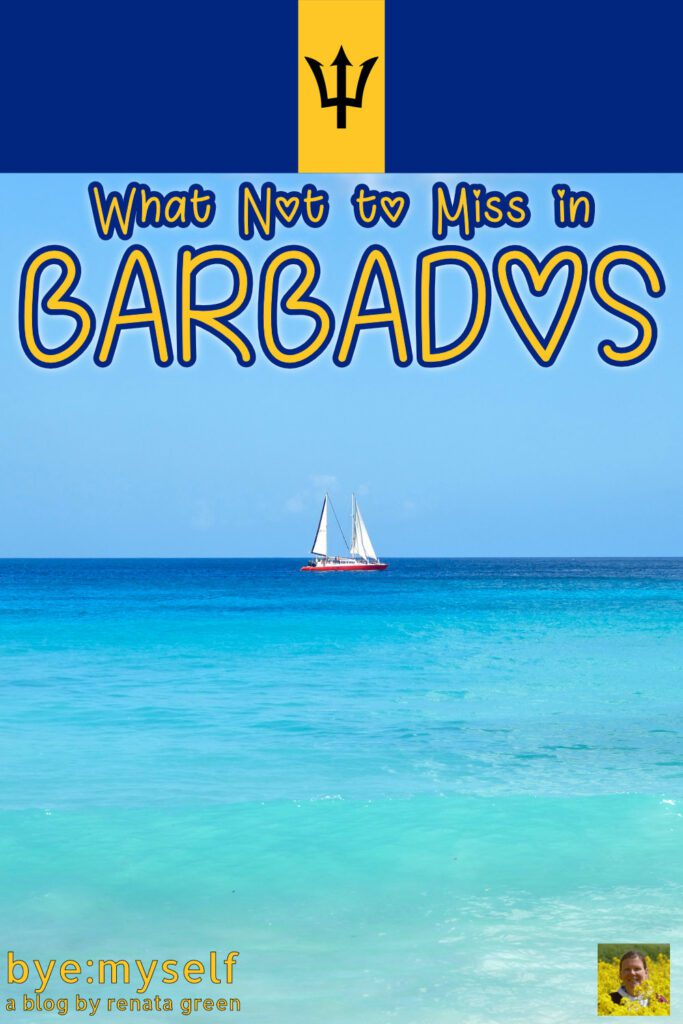
Did You Enjoy This Post? Then You Might Also Like These:
The Best Beaches in Guadeloupe You Can Easily Visit by Public Bus
Murals in CURACAO: The Best Street Art Projects in Willemstad
PLAYA SANTA LUCIA – Cuba’s Secluded Tropical Paradise
The Best Beaches in Martinique You Can Easily Visit by Public Bus
BONAIRE Totally Unexpected: Street Food And Urban Art Tour
Beyond Your Imagination: The 15 Best Beaches in Barbados You Can Easily Visit by Public Bus
Best Places to Visit in Basse Terre, the Western Wing of GUADELOUPE (also by public bus)
As Easy As ABC: Island Hopping Between ARUBA, BONAIRE, and CURACAO
* This is an affiliate link. Hence, If you book through this page, not only do you get the best deal. I also get a small commission that helps me run this blog. Thank you so much for supporting me!
** I am very appreciative that Saint Nicholas Abbey, Sunbury Plantation, as well as Welchman Hall Gully invited me to visit the site and experience their facilities. Nevertheless, all descriptions and opinions are mine and were in no way influenced by them.
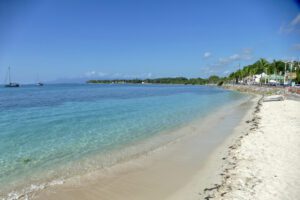
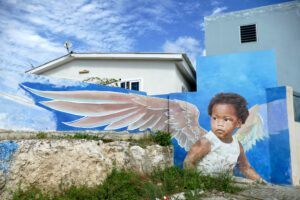
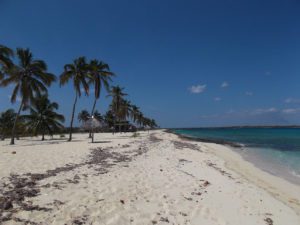
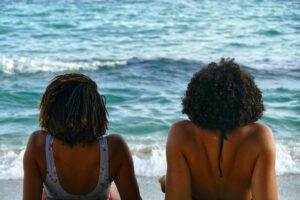
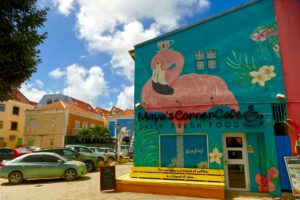
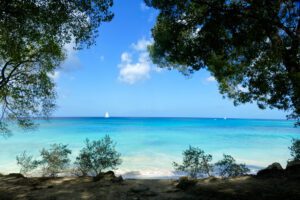
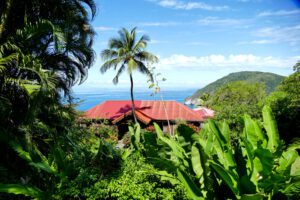
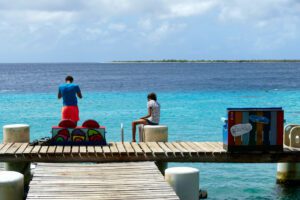
Your passion for travelling shines through in every post. It’s clear that you genuinely care about sharing all your knowledge and making a positive impact on your readers. Kudos to you!
Thank you for your lovely comment. Yes, I definitely try to offer the best service to my readers – and I’m very happy you appreciate it 🙂 Happy travels!